

Which Paris Metro Tickets Or Passes Should You Buy In 2024
Traveling to Paris but are not sure which Paris metro tickets or Passes to buy ? Then this article will help you figure that out!
In my last article, I showed you exactly how to use the Paris metro . Today, I want to go a bit further and talk about the different types of metro tickets available.

Disclaimer: This post might contain affiliate links. This means we may earn a small commission (at no extra cost to you) should you choose to sign up for a program or make a purchase using one of our links. It’s okay – We love all of the products we recommend anyway, and you will too! Also, that commission helps us keep this awesome free blog up to date! You can read our full disclosure here for more details!
With several options like the Navigo Easy Pass, the classic T+ tickets, the Paris Visite Pass, and the Navigo Découverte Pass, it can be quite overwhelming to choose the right one, and figuring out the transportation zones doesn’t make it any easier.
So in this article, I’ll talk about all the Paris metro tickets and passes available to make sure you choose the right one!
Before You Go, Here’s How to Plan Your Visit To Paris: Practical Quick Tips
WHERE TO STAY Best Eiffel Tower Views: Hôtel Le Walt (9.0) Luxury stay: Pullman Paris Tour Eiffel (8.2) Mid-range stay: Hôtel Eiffel (8.7) Budget Stay: People – Paris Bercy (8.9) Apartment Rental: Résidence Charles Floquet (9.1)
BEST GUIDED TOURS Louvre Museum guided tour : (4.5/5) Seine River Dinner Cruise : (4.7/5) Montmartre Walking Tour : (4.8/5) Le Marais Walking Food Tour : (4.5/5) Versailles Guided Tour : (4.8/5) Eiffel Tower Guided Tour : (4.4/5) Private Transfer from CDG Airport to Paris : (4.7/10)
MUST-DO EXPERIENCES HAPPENING NOW IN PARIS Luminiscence at Saint-Eustache Church : A music and lighting show in one of Paris’s most beautiful churches: (4.7/10) Candlelight show : Perfect if you want to be treated to a candlelit music show in a beautiful Parisian venue: (4.8/10) Cabaret at Moulin Rouge : A cabaret in the iconic Moulin Rouge is a must: (4.7/10)
What are the Transport Zones in Paris?
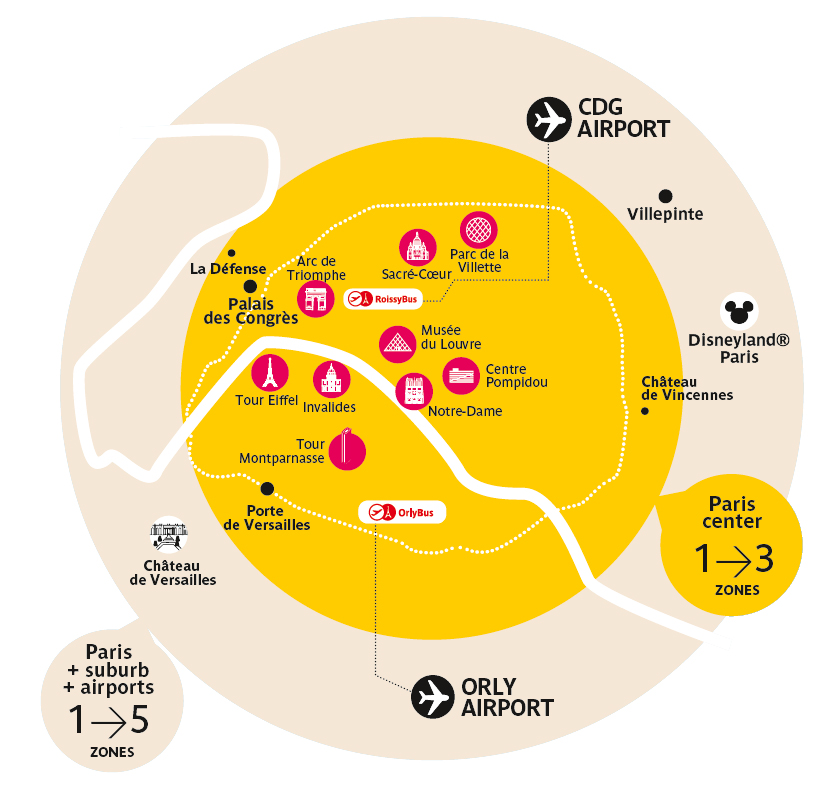
To decide which ticket or pass to buy, you need to understand the transportation zones of Paris.
This is often the most confusing part of navigating the city’s transport system but I’ll try to simplify it as much as possible.
The first thing to know is that Paris’s transportation system is divided into 5 different zones.
Zone 1 encompasses central Paris covering all the 20 arrondissements or districts.
Zone 2 includes suburbs close to the city including Boulogne-Billancourt, Montrouge, Ivry, and Stade de France.
Zone 3 stretches further out, featuring places like La Défense, the Basilica of Saint-Denis, Parc de Sceaux, and Château de Vincennes.
On the other hand, Zone 4 has the Palace of Versailles and Orly Airport.
Zone 5 reaches the farthest, including Parc Astérix, Disneyland Paris, Provins , Fontainebleau Castle, and Charles de Gaulle (CDG) Airport.
Now that you know which popular attractions fall into each zone, let’s look at the different types of tickets available.
Paris Metro Tickets And Passes
T+ single journey ticket.

The T+ single journey ticket costs €2.10 for a full fare and half that price for children aged 4 to 11. Kids under 4 years old can ride the metro for free.
You can use this ticket on the metro, buses (except the Orlybus and Roissybus, which serve Orly and CDG airports respectively), and trams throughout the Île-de-France region. You can also use it on the RER but only within Paris, meaning just Zone 1.
For example, you can travel to La Défense using a T+ ticket on the metro, bus, or tram, but not on the RER, since La Défense is in Zone 3, not Zone 1.
This ticket also allows you to transfer between metros, buses, and RER trains within 90 minutes of the first validation. However, you cannot transfer between different types of transportation (e.g., from metro to bus, or tram to RER).
You can purchase the T+ ticket as a physical paper ticket or load it electronically onto a Navigo Easy Pass, which we will discuss next.
Navigo Easy Pass

The Navigo Easy Pass costs just €2 and can be loaded with any number of T+ tickets directly from the RATP counter, ticket vending machine, or even via the RATP or Île-de-France Mobilités apps on your phone.
If you’re not sure how to do this, you can check out my recent YouTube video here .
You can also load the pass with a bundle of 10 tickets, known as a ‘Carnet,’ which is more cost-effective than purchasing 10 individual tickets.
Is the Navigo Easy Pass worth it?
Absolutely. It saves you time since you won’t need to queue for tickets each time, and it also saves money when you buy tickets in bulk.
Just like the paper ticket, you can use this pass on the metro, buses, and trams throughout the entire Île-de-France region, but remember, it’s only valid in Zone 1 for the RER.
One-day Navigo travel Pass
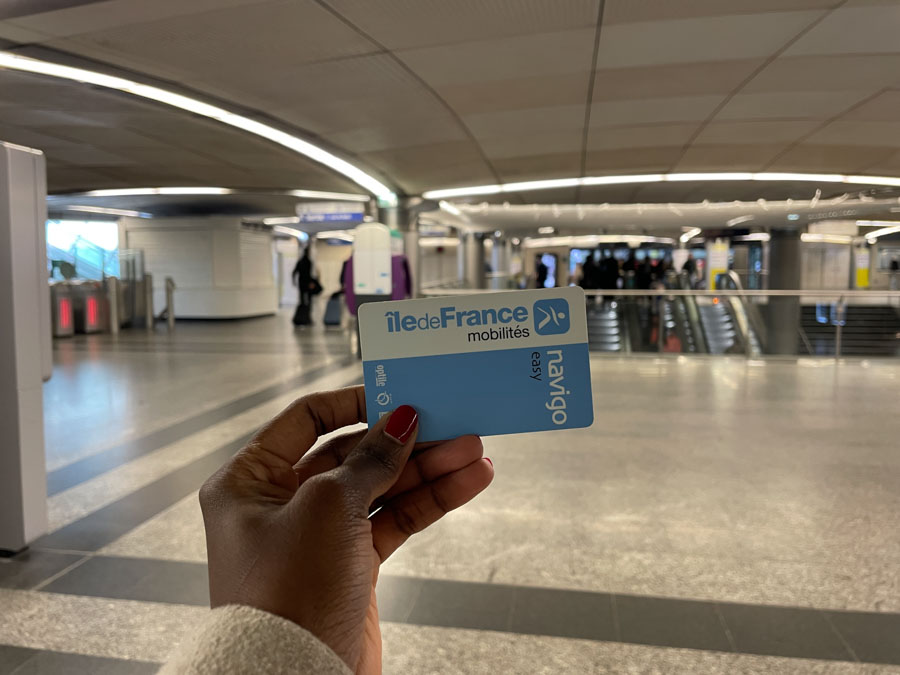
Another option to consider is the One-Day Navigo Travel Pass , which can be loaded onto a Navigo Easy Pass or a Navigo Découverte Travel Card — we’ll talk more about the latter option later in the article.
When purchasing this pass, you need to select at least two zones, with combinations available from Zones 1 to 2, up to all 5 zones. For any two zones, it costs €8.65; three zones cost €11.60; four zones, €14.35; and all five zones are €20.60
This pass grants you unlimited rides on all transportation modes within the chosen zones until midnight on the day of purchase, excluding the OrlyBus and RoissyBus services.
Is the Navigo One-Day Pass worth it?
It’s convenient as it saves you from needing to recharge your card throughout the day. However, you’ll need to do the math to see if it’s more cost-effective than buying T+ tickets and individual tickets for each trip, especially outside Zone 1.
To give you an example, let’s assume you’re planning to visit Disneyland Paris which is located in Zone 5.
If you choose a day pass covering all 5 zones for €20.60, you might find it slightly more expensive compared to buying individual round-trip Disney tickets at €5.50 each way, plus 2 or 3 T+ tickets for additional rides in Paris.
And if you’re just spending a day in central Paris (Zone 1), the pass breaks even if you use the metro, bus, or tram at least four times. So, calculate based on your travel needs to decide if this pass is cost-effective for your itinerary.
Navigo Youth Weekend Pass
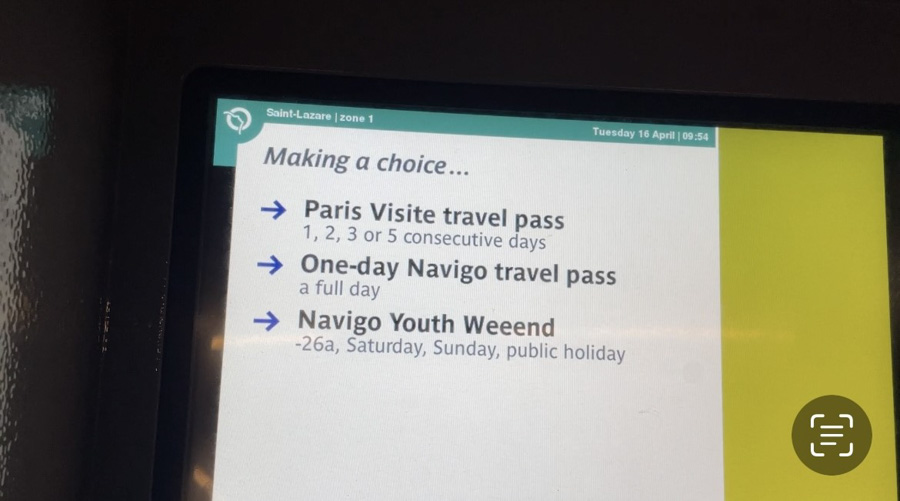
If you’re under 26 years old, consider the Navigo Youth Weekend Pass . It costs €4.70 for zones 1 to 3, €6.05 for zones 3 to 5, and €10.35 for all 5 zones.
It offers unlimited transportation on the metro, RER, and buses, but note that it’s only valid on Saturdays, Sundays, and public holidays.
Is the Navigo Youth Weekend Pass worth it?
Absolutely! If you’re under 26 and in Paris for the weekend, this pass is a no-brainer. It’s not only affordable but also incredibly practical for extensive travel across the city.
Paris Visite Travel Pass
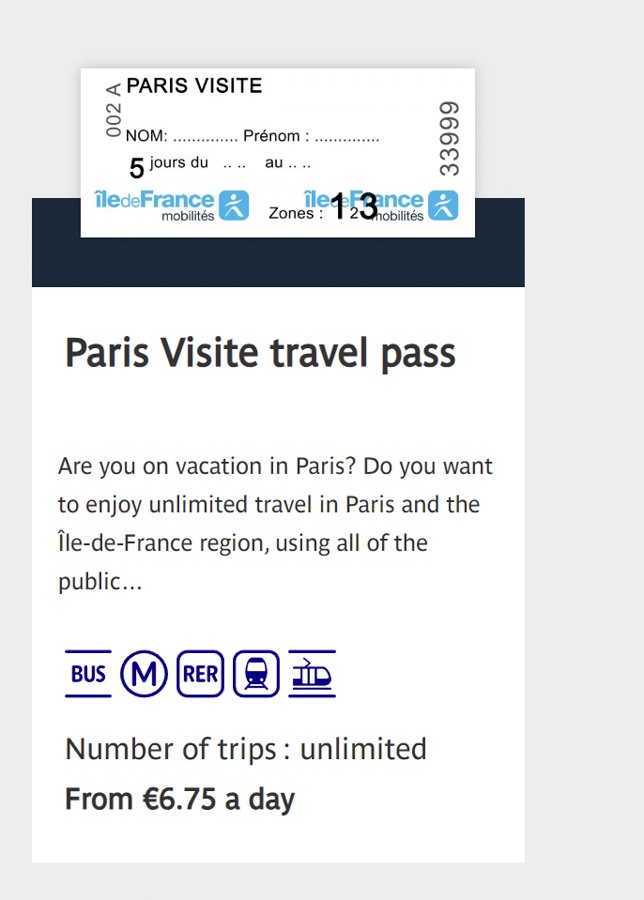
The Paris Visite Travel Pass is a pass that gives you unlimited access to all forms of transportation be it the metro, bus, tram, RER, and SNCF trains in the Île-de-France region for either 1, 2, 3, or 5 consecutive days.
The daily price depends on the zones you select, starting at €13.95 for zones 1 to 3 and going up to €29.25 for zones 1 to 5.
With this pass, you can easily visit major attractions such as Disneyland Paris , Versailles, and Fontainebleau Castle, and travel to Orly and CDG airports.
You may also get discounts on some popular landmarks in Paris . Just remember to write your name and the dates on the ticket for it to be valid.
Is the Paris Visite Travel Pass worth it?
While it’s convenient for accessing various landmarks, this pass is somewhat more expensive compared to other options.
For example, a one-day pass for zones 1 to 3 costs €13.95, whereas the Navigo One-Day Pass for the same zones is only €11.60.
Similarly, for all 5 zones, the Paris Visite costs €29.25 compared to €20.60 for the Navigo One-Day Pass.
Navigo Découverte Travel Card
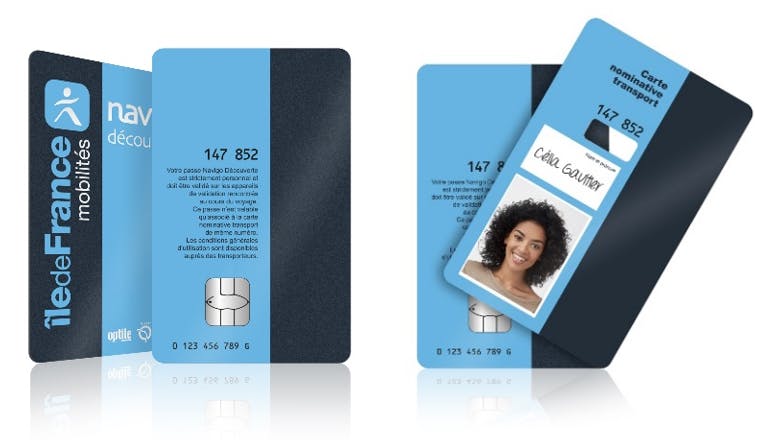
The Navigo Découverte card offers a flexible way to travel around Paris and its neighboring suburbs, covering all forms of transportation from zones 1 to 5.
The card itself costs €5, and you can load it with various types of passes including the Youth Weekend Pass and the 1-Day Navigo Pass we looked at earlier, or a Weekly Pass.
The Weekly Pass costs €30.75 for all zones, and although it sounds like a good deal, it comes with certain limitations.
It is only valid from Monday to Sunday midnight, regardless of when you start using it, and it can only be purchased starting on the Friday before your travel week.
Additionally, you must write your name on the card and attach a passport photo. If you don’t have a photo, you can take one at the photo booths available in various metro and train stations.
You can also purchase this pass on your phone, which eliminates the need for a physical card, though be aware that validation machines sometimes fail to read from phones.
For Android users, there’s an option to buy tickets directly on the phone, but this feature isn’t yet available for iPhones — though it’s expected by May 2024.
Is the Navigo Découverte Travel Card worth it?
The value of the Navigo Découverte card depends largely on your travel plans. If you’re staying in Paris from Monday to Sunday, or even for four days, and plan to visit places like the Versailles palaces, and Disneyland Paris, and travel to and from CDG airport , then it is worth it.
Just the round trips to the airport by train would cost €23.60, Versailles would be €8.10, and Disneyland Paris €10, totaling €41.70, which already exceeds the cost of the pass, making it a cheaper option.
However, if your visit is concentrated in zones 1 and 2, or you arrive mid-week, the pass might not be the best value. As always, do the math based on your specific trip.
Paris Metro Price Changes During the 2024 Olympics
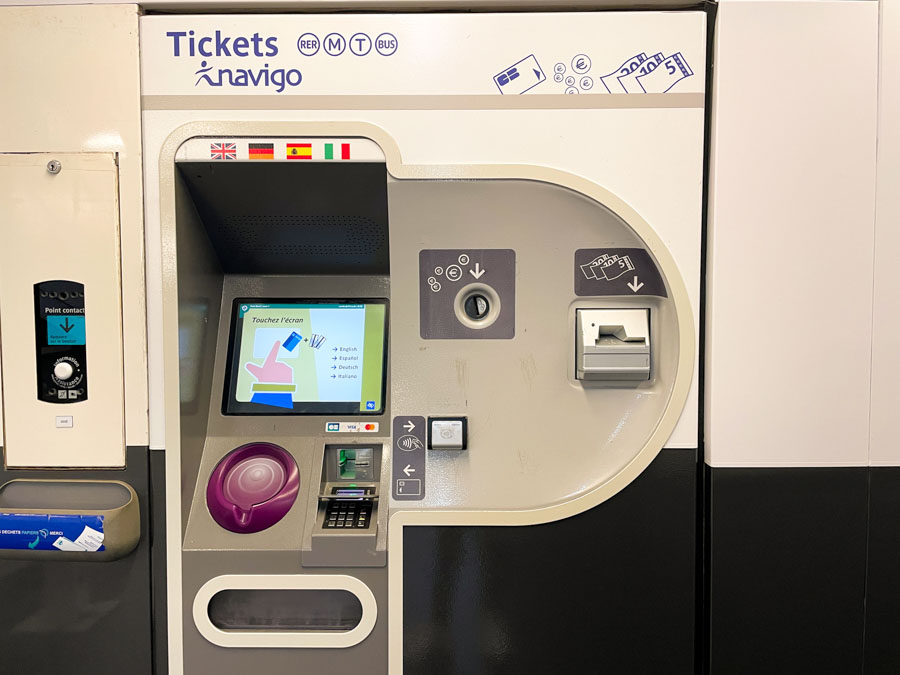
If you’re visiting Paris during the Paris 2024 Olympics, you should note that the metro ticket prices will go up from July 20 to September 8.
The cost for a single ride t+ ticket will jump from €2.15 to €4, and a bundle of 10 tickets from 17.35 € to €32.
However, a special pass known as the Paris 2024 Pass will be available for €16 a day or €70 a week, covering travel in Paris and to both Charles de Gaulle and Orly airports.
During this period, the Navigo Découverte Travel Card and the One-Day Navigo Pass will not be available for purchase.
With all that being said, what’s the best ticket option for your time in Paris?
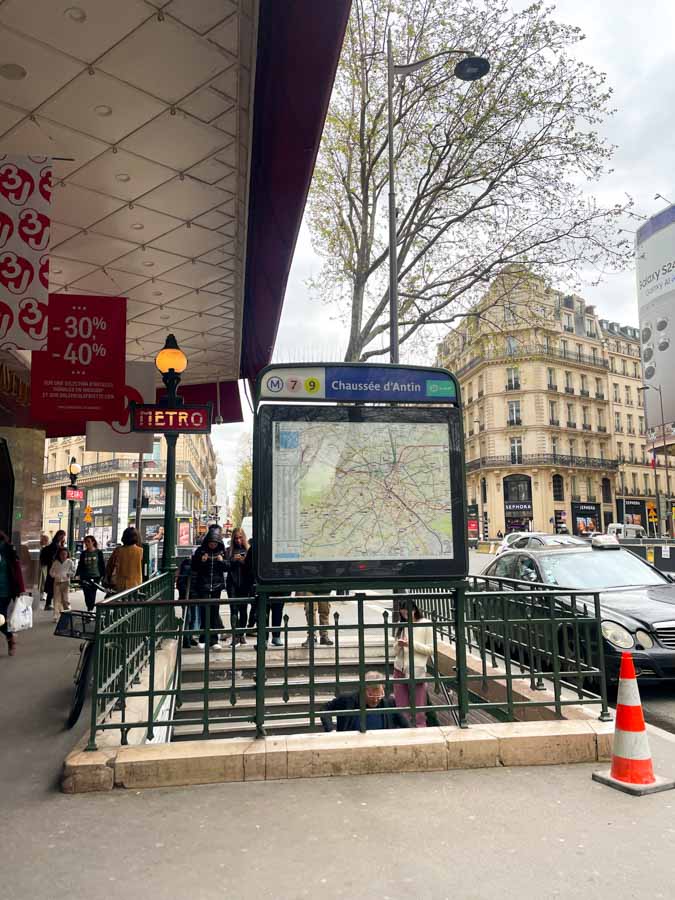
Ultimately, the right choice depends on several factors including the number of days you’re in Paris, the places you plan to visit, and the zones you’ll be traveling through.
If you’re mainly staying in central Paris and don’t plan any day trips to places like Versailles, Disneyland, or Fontainebleau Castle, I’d recommend purchasing a carnet of 10 tickets on a Navigo Easy Pass. It is more convenient and offers more value.
And although I find the Paris Visite Travel Pass to be more expensive than the other options available, it might still make sense for your specific itinerary if you’re planning extensive travel across multiple zones. As I mentioned earlier, do the math and see what works for your trip.
Check out these posts to help you plan your trip to Paris
- Big Mistakes to Avoid in Paris
- What Not to Wear in Paris
- Important Things to Know Before Traveling to Paris
- The Ultimate Paris Bucket List
Was this post on the different Paris metro passes and tickets helpful? Then please consider sharing it with others.
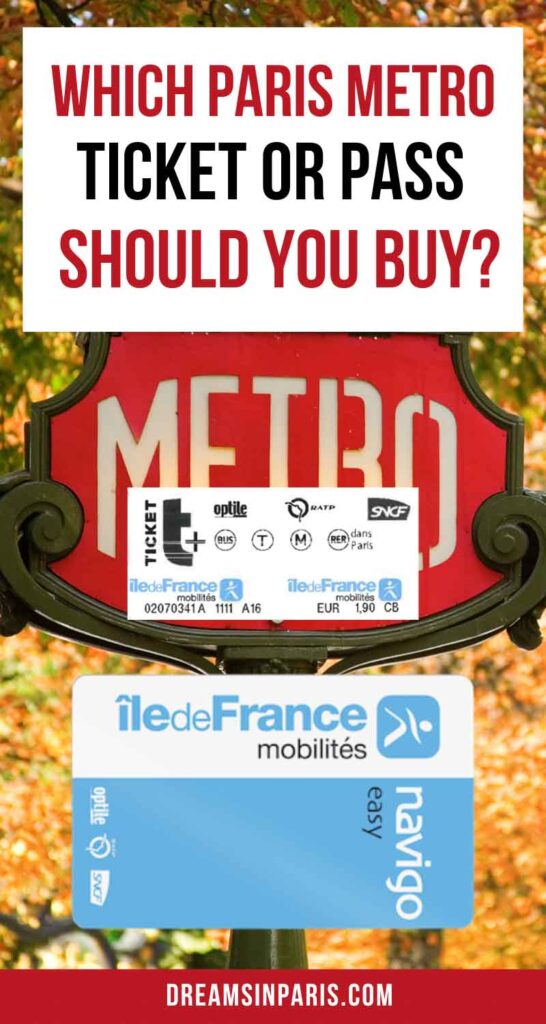
Sharing is caring!
Esther is the face and voice behind Dreams in Paris! She has always been obsessed with Paris even before she moved there. She has lived in Paris for a couple of years, and that obsession has not changed! That love for Paris, plus her passion for writing led to the birth of Dreams in Paris! She now shares all the practical tips and guides she’s picked along the way to help you plan a memorable trip to the city of love! You can learn more about her here !
Similar Posts

How To Get From CDG To Paris In 2024 (5 Best Possible Ways)
Not sure how to get from CDG to Paris? This post will give you detailed options to choose from depending on your travel style including the pros and cons for each! If you’re planning to visit Paris, you’re in for…

How to Get From Paris to Disneyland Paris (5 Possible Ways)
Planning your trip to Disneyland Paris but not sure how to get there? Then this post will give you various options on how to get from Paris to Disneyland Paris! As someone who lives in Paris and has visited Disneyland…
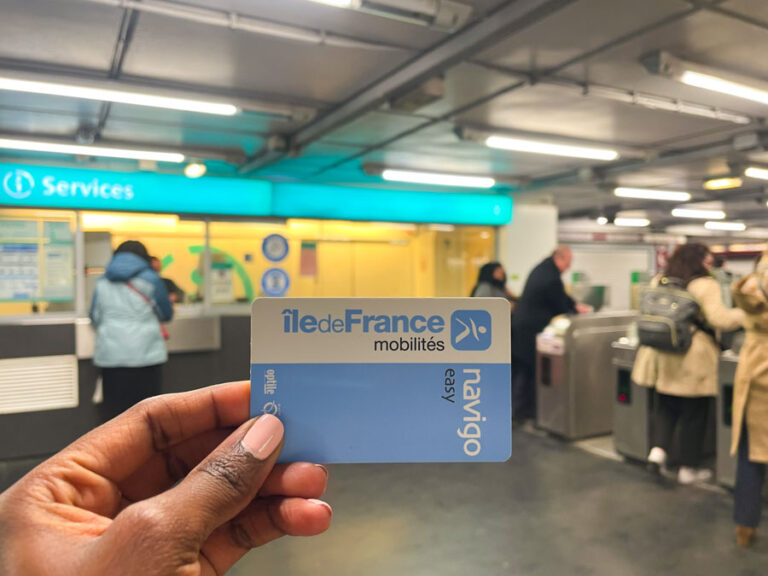
15 Big Mistakes To Avoid on The Paris Metro
This article will show you the biggest mistakes to avoid on the Paris metro if you don’t want to get fined! In previous article, I showed you exactly how to use the Paris metro. And while it’s easy to navigate,…

How To Get From Paris To Versailles Palace (6 Best Possible Ways)
Are you planning to visit Versailles but not sure how to get there? This article will give you various options on exactly how to get from Paris to Versailles! The Palace of Versailles is undoubtedly one of the most beautiful…
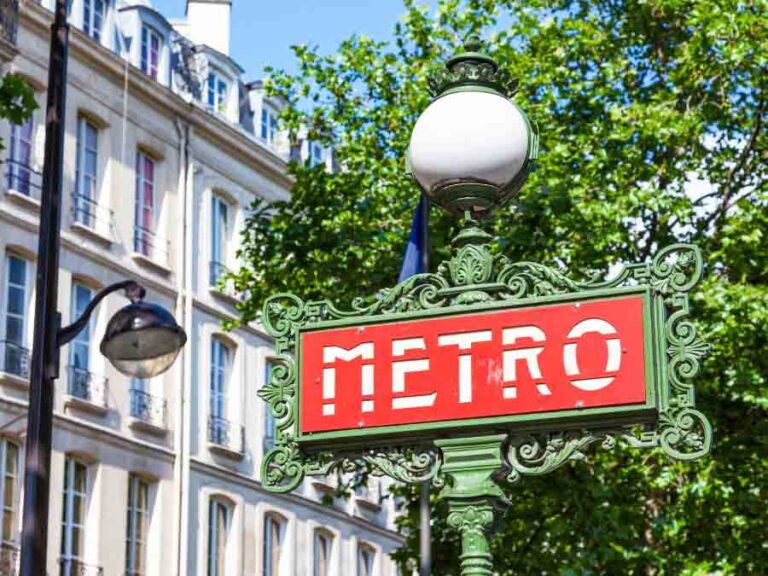
How to Use The Paris Metro In 2024 (+ Practical Tips)
Traveling to Paris for the first time but you’re not sure how to navigate the metro? Then this article will show you exactly how to use the Paris metro! If you’re traveling to Paris, you’re likely to use the metro…
Leave a Reply Cancel reply
Your email address will not be published. Required fields are marked *
Save my name, email, and website in this browser for the next time I comment.
This site uses Akismet to reduce spam. Learn how your comment data is processed .

Home > Getting Around Paris > Paris Metro Tickets 2024 (and Best Paris Metro Pass for Tourists!)
Paris Metro Tickets 2024 (and Best Paris Metro Pass for Tourists!)
Paris metro guide for tourists.
All about the Paris Metro for tourists: Paris Metro tickets 2024, Paris Metro pass options, and how to navigate the Metro of Paris.
The Metro of Paris is Europe’s best subway system and allows locals and visitors to go from one point to another in Paris quickly and cheaply. Inaugurated in 1900 for the Paris World Fair , the centenary Paris Metro has grown organically, trying to adapt to the city’s new needs. For this reason, the Metro of Paris is a labyrinthine (sometimes chaotic) network of railroads, corridors, and metro stations, and it can be overwhelming for first-timers in Paris .
The good news is that,, with the right information, the Paris Metro system is relatively easy to use and a great way to discover Paris like a local.
This quick guide to the Paris Metro for tourists gives information on the different Paris Metro tickets 2024 (and how to buy them) and our best tips on how to use the Paris Metro 2024. If you want to know if any Paris Metro Strike is scheduled during your coming trip to Paris, then head to this post .
Are You Planning a Trip to Paris Last Minute?
If you are booking a last-minute trip to Paris, I’ve got you covered! Below are our must-guides, top tours, hotels, and more:
» Plan: Paris Travel Planner ; Paris Arrondissements Guide ; Check out the best Paris Metro tickets for tourists
» Book your flight tickets with Omio ; book your train tickets with Omio
Book your transfer from the airport to the city with Welcome Pickups .
» Where to Stay: Best Districts to Stay in Paris
- Le Pavillon de la Reine (historical 5-star hotel in Le Marais)
- Hotel La Comtesse (mid-range hotel with Eiffel Tower view from all the rooms!)
- Hotel Ducs de Bourgogne (super central 4-star hotel near the Louvre)
» Top-Rated Paris Tours & Tickets:
- Louvre Museum Skip-the-Line Ticket
- Eiffel Tower Summit Access Ticket
- Seine River Night Cruise
- Catacombs Skip-the-line tour with VIP access to restricted areas
Want skip-the-line access at museums & attractions in Paris? Get your hands on a Paris Museum Pass !
» Don’t leave without travel insurance! Safety Wing works well for long and short trips (starting with a minimum of 5 days). SafetyWing covers COVID-19 for new policies purchased, and unplanned quarantine is covered, too.
Content of this Paris Metro Guide 2024
- Paris Metro Tickets 2024
- Navigo Easy: Best Paris Metro Pass for Tourists
- Paris Metro Day Pass 2024: Is it Worth it?
- Other Metro Paris Tickets 2024
- Paris Metro Lines and Paris Metro Map
- Paris Metro Hours and Paris Metro Rush Hour
- How to Use the Paris Metro – Top Local Tips
- Metro of Paris Etiquette
- When Things Go Wrong
- How to Avoid Pickpockets in the Metro of Paris

1. Paris Metro Tickets 2024
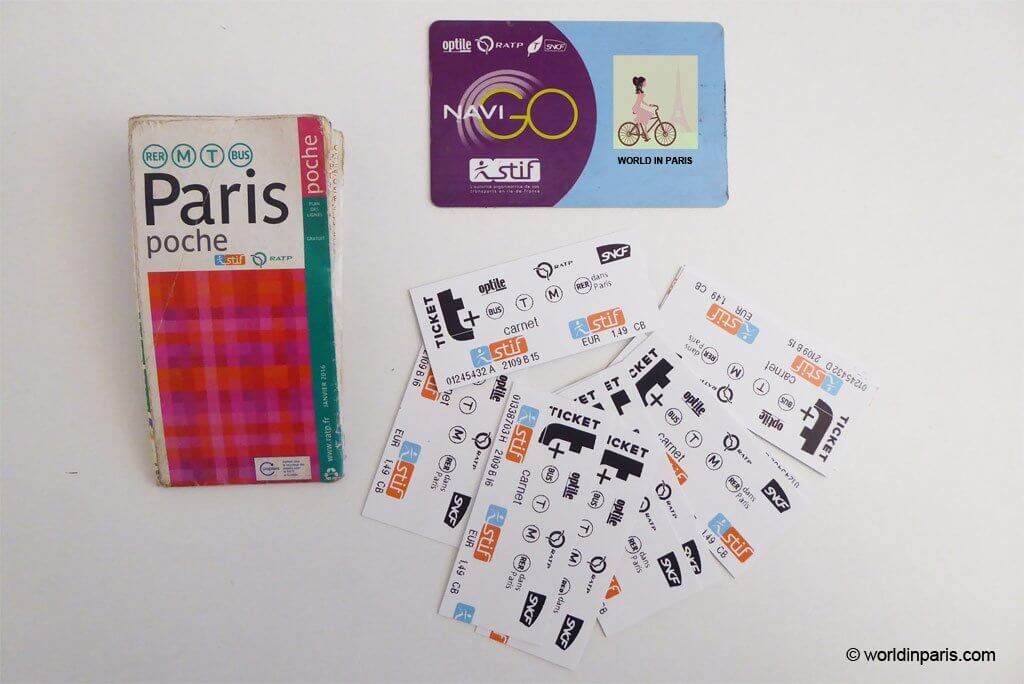
The Paris Metro tickets are also called T+ tickets. You can use the Paris Metro tickets for zones 1-3 only (= within Paris) for the next 90 minutes after validation (without exiting the network). With this Metro Paris ticket, you can also travel by bus, tramway, RER (within the limits of Paris), and Montmartre’s funicular.
GOOD TO KNOW: With a Ticket T+, you can connect for free between metro-metro, RER-RER, and metro-RER in central Paris for 90 minutes from your first validation. You can take the Montmartre funicular with a Ticket T+, but you cannot connect to other modes of transport.
The T+ tickets are only valid for getting around Paris. To go from Paris to Versailles, Fontainebleau, or Disneyland Paris, a Billet Ile de France (Ile de France ticket) is necessary. The Billet Aéroport is the ticket to buy if you want to travel to the Airports in Paris.
TIP: Always keep your Metro Paris ticket until you leave the Metro. Ticket controls are frequent in the Paris Metro, especially at the beginning and end of the month.
Paris Metro Prices 2024
The Paris Metro ticket price is 2,15 €. The T+ ticket comes with a few discounts, which are the following:
> A pack of 10 T+ tickets (called Carnet de Dix in French) costs 17,35 € , which means 1.73 € /ticket.
> A pack of 10 T+ tickets at a reduced price (called Carnet de Dix Tarif Réduit in French) is available for kids from 4 to 9 years old and costs 8,65 € . A passenger with a reduced fare ticket must be able to prove their right to the reduction at any time during their trip (e.g., with an identity card). There is no single T+ ticket with a reduced price for kids.
These are the Paris Metro prices 2024. The Paris Metro prices usually change every year in January.
PARIS METRO TICKET PRICE DURING THE OLYMPICS 2024:
The price of the Paris metro ticket will almost double during the Paris Olympics 2024 !
The increase in the price of several transport tickets in Paris and the Ile-de-France region has been decided in order to ensure the increase in the offer during the peak period. It will not apply to monthly and annual passes such as Navigo.
From 20 July to 8 September 2024 , the Paris metro ticket will increase to 4 € (from 2,15 € currently) and the carnet de dix (booklet of 10 T+ tickets) to 32 € (from 17,35 € currently).
Paris frequent travelers can avoid this increase in price by loading their Navigo Easy with tickets before July 20. As a reminder, a Navigo Easy card can be loaded with three “carnets de dix” (3×10 T+ tickets) maximum. If you plan to use the metro more than 30 times, buy another Navigo Easy card for 2 € and load it fully. It is not possible to load a Navigo Pass (weekly, monthly, etc.) with T+ tickets.
How to Buy Paris Metro Tickets
Because Paris Metro T+ tickets are now virtual, you can buy these Paris Metro tickets online, with your phone, or load them onto a physical Paris Metro card.
> On Your Phone: buy and validate your tickets with your phone via any of the free RATP apps.
> On a Paris Metro Card: purchase the Navigo Easy card (a plastic card) and use the vending machines or your phone to buy and top up your tickets. Then, use the card to validate your tickets.
IMPORTANT: The sale of paper tickets T+, alone or in a pack, is now permanently discontinued in Metro stations and stops. Today, Paris Metro tickets T+ are only virtual , and you must upload them on a Paris Metro card or your phone (more on this below).
Can I buy Paris Metro tickets in advance?
> Your Phone: you can buy Paris Metro tickets online (=upload them on your phone or a physical card) if you have any of the RATP apps. To view, purchase, or validate tickets, NFC Activation is necessary.
> Vending Machine: you can buy Paris Metro tickets in advance (=upload them on your physical card). I always buy a bunch of Paris Metro tickets at the end of the year because I know that in January, the Paris Metro ticket price will be higher.
Where to Buy Paris Metro Tickets
> Your Phone: you can buy Paris Metro tickets online anywhere, as long as you have your phone. Simply download one of the free RATP applications available on the App Store and Google Play: Ile-de-France Mobilités and Bonjour RATP . To view, purchase, or validate tickets, NFC Activation is necessary.
> Physical Card: First, you need to purchase the physical card ( Navigo Easy ) at one of the Metro Information Kiosks. The Navigo Easy card cost is 2 € . When you buy your card, you can ask the staff to upload it with a few T+ tickets or a pack of 10 tickets (called “carnet de dix” in French).
For the next time, you can upload T+ tickets on your Navigo Easy card with your phone (if you have one of the RATP apps installed) or at the metro, tram, and train stations (RATP and SNCF stations). In the Metro, you will have to use the vending machines located at the entrance before the tripods.
The Information Kiosks at the Metro only provide information. If you ask kindly (s’il-vous-plait,…), they can upload the Navigo Easy card for you when you purchase it, but that’s all. The Metro staff in the Information Kiosks only inform Metro users and eventually help them if there is a problem with their tickets or Paris Metro pass.
2. Navigo Easy: Best Paris Metro Pass for Tourists
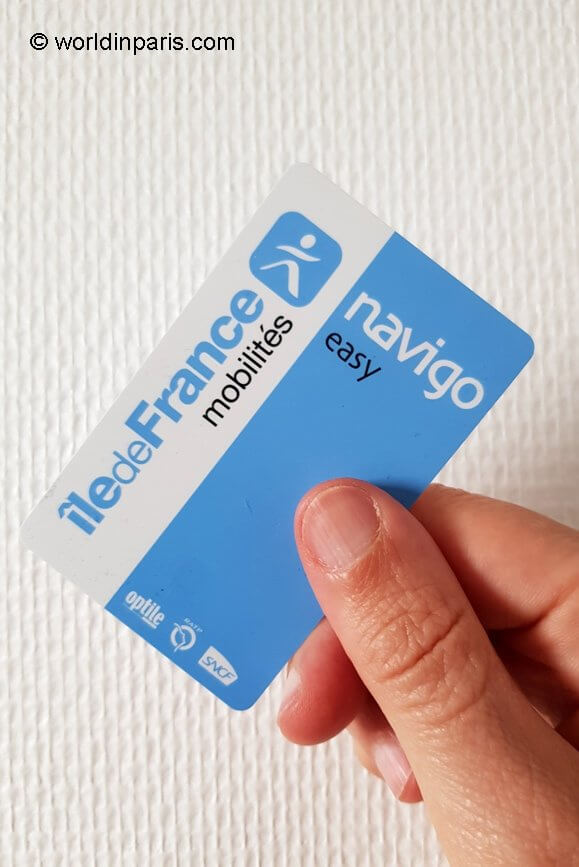
Finally! Visitors or occasional Metro travelers in Paris have a loadable pass perfect for their needs. The Navigo Easy Pass is a flexible and convenient Paris Metro card that can be loaded with T+ tickets, Orly Bus tickets, Roissy Bus tickets, or a Paris Metro Day Pass. In my opinion, the Navigo Easy Pass is the best Paris Metro Pass for tourists.
The Navigo Easy Pass is an individual Paris Metro pass. This means that several people CAN NOT travel simultaneously with the same card. However, it is not a personal pass, so you can lend it to somebody if you don’t use it.
Unlike other Paris Metro passes, the Navigo Easy Pass has no validity limit; you can use it and load it as many times as you want for ten years!
You can buy, use, and reload the Navigo Easy Pass with your smartphone (if you have one of the RATP apps). The descriptions below are for those who prefer to use the Navigo Easy Pass as a physical card.
How to Load Your Navigo Easy Pass at the Metro Station
First, you must buy a travel card at one of the Metro Information Kiosks. The Navigo Easy plastic card costs 2 €. When you buy it, the vendor will ask you if you want him to load it with tickets. Tell him “ Un Carnet de Dix, s’il-vous-plait ” – or the number of tickets you want, – and he will do it for you. That was easy!
Next time, you must load it yourself in the vending machines. Instead of writing a long description, I took pictures of every step.
By default, the machine will communicate with you in French, but we will change this too. Use the roller to move through the options and the green button to validate. You can pay your purchase with cash or a card.
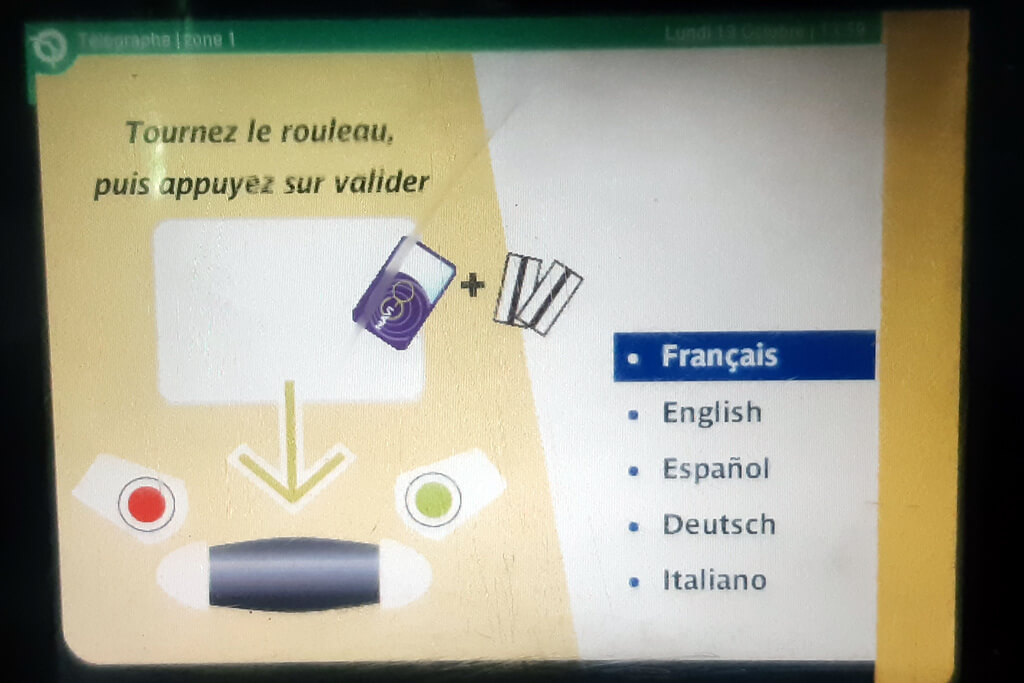
Don’t take the credit card back until the machine tells you to do so. The machine loads the tickets on your card only after the payment is approved. Same with the Navigo Easy card: don’t take the Navigo Easy card back until the machine tells you so. And that’s it!
How to Check Your Navigo Easy Pass Balance at the Metro Station
It is very easy! Go to any vending machine and follow steps 1 to 5. In step 5, on the right corner of the screen, the machine tells you how many tickets are left in your pass (Pass Contents). When I took the picture, my balance was 10 tickets.
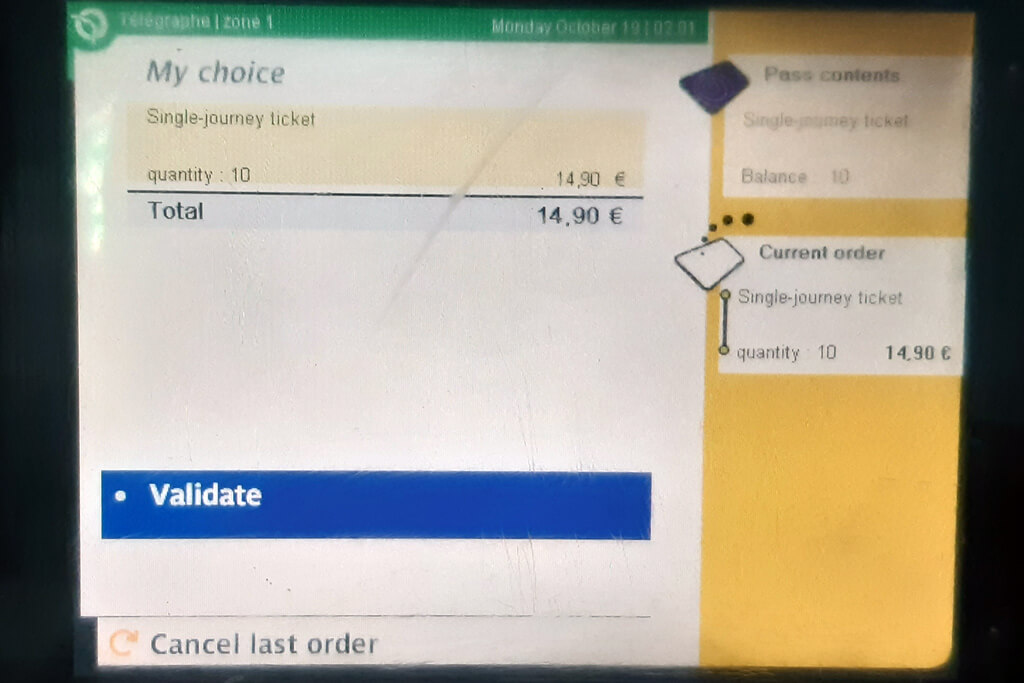
Then, go on with the process – if you decide to buy more tickets – , or take your Navigo Easy card back. I promise to take a better picture soon!
You can also check the balance when you validate your ticket at the tripods (but sometimes, it is difficult to see).
3. Paris Metro Day Pass 2024: Is it Worth it?
The Paris Metro Day Pass (Navigo Day ticket) allows unlimited travel for one day, from 12 a.m. to 11:59 p.m., with the same conditions as T+ tickets.
You can buy and use the Paris Metro Day Pass with your smartphone (if you have one of the RATP apps) or upload it to one of the following Paris Metro cards: Paris Navigo, Navigo Découverte, or Navigo Easy.
You can buy this pass up to 6 days in advance. It will start working after the first validation on the day and until the end of the metro service that same day. The Paris Metro Day Pass 2024 costs 8,65 € (zones 1-2, 2-3, 3-4, 4-5) and 20,60 € (zones 1-5).
Is the Paris Metro Day Pass 2024 good for tourists? The Paris Metro Day Pass can be a good pass if you plan to use public transport in Paris a lot in one day. If you buy a 10-ticket booklet, the cost of a single ticket is 1.73 €. If you plan on using the metro 6 times or more during the day, then the Paris Metro Pass will be cheaper than a booklet of 10 T+ tickets.
4. Other Metro Paris Tickets 2024
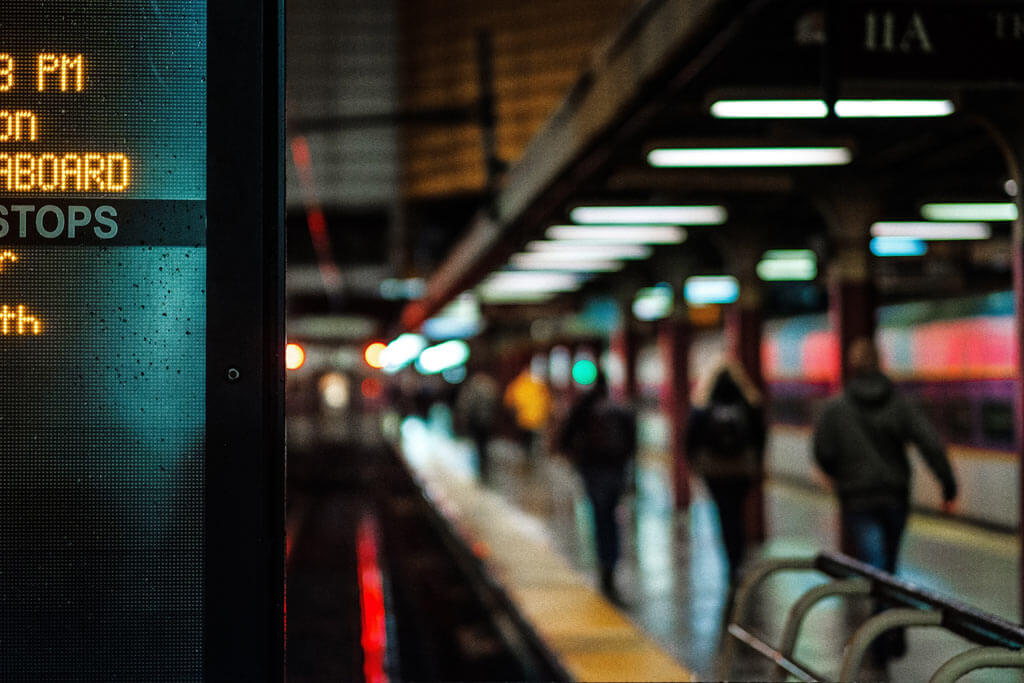
The Metro of Paris proposes different Paris Metro passes (called forfaits in French) for different prices and durations. Below, we only mention the most interesting passes for tourists:
Navigo Pass (Daily, Weekly, Monthly, Annual)
The Navigo Pass is the most used pass by the locals. Paris’ Navigo Pass allows unlimited rides with all the public transportation in Paris and the Ile-de-France region (except Orly Val) during a day, a week, a month, or a full year.
> Navigo Daily Pass is described above.
> Navigo Weekly Pass is valid for one week, from Monday to Sunday. You can buy the pass from Friday of the previous week until Thursday of the week you want to use it. If you decide to buy it on Thursday, for example, you will only use this pass for four days (Thursday, Friday, Saturday, and Sunday of the same week). The cost of this pass is 30,75 € (all zones). “All zones” is the option to choose from, even if you only want to travel around Paris.
> The Navigo Monthly Pass is valid for one month, from the first day until the last day of the month. The cost of this pass is 86,40 € (all zones). “All zones” is the option to choose, even if you only want to travel around Paris.
You can load this Navigo Pass on your phone via any of the RATP apps. If you prefer to use it with a physical card, first, you need to purchase one of the two following Paris Metro cards: Navigo travel card or Navigo Découverte travel card. Once you get the card, charge it with the best Navigo Pass for you (check Chapter #2 for how to load it).
> The Navigo Travel Card is available for Paris and Ile-de-France residents. It is free upon presentation of proof of residence (e.g., an invoice with your address in Paris or Ile-de-France). You also need to bring a picture to get this card.
> The Navigo Découverte Travel Card is available for everybody (residents and non-residents), and it costs 5 €. You also need to bring a picture to get this card.
You can purchase these Paris Metro cards from the following commercial agencies:
Gare Paris Saint Lazare, Gare du Nord, Gare de Lyon, Bibliothèque François Mitterrand, Gare de Montparnasse, Charles de Gaulle-Etoile Station, and Pereire-Levallois Station.
Navigo Liberté+ Pass
This is an ideal option for occasional travelers, as long as they have a French bank account. It allows you to use all transport within Paris, Funicular of Montmartre included. All you have to do is validate this Paris Metro card each time you travel.
Each journey costs 1.69 € (excluding OrlyBus/RoissyBus), compared to 2.10 € for a single T+ ticket. If you have to make several journeys during the day, you will pay a maximum of 8.45 € . You will be charged at the end of the month depending on the number of journeys made.
To benefit from it, simply go to one of the commercial agencies mentioned above, providing your contact details and French bank account IBAN. The Navigo Liberté + contract is available exclusively on a personalized Navigo travel card (with your first and last name and your photo).
Paris Visite Pass
The Paris Visite Pass for 1, 2, 3, or 5 consecutive days, can be very convenient, especially if you are traveling outside of Paris, in the Ile-de-France region. This Metro pass Paris + Ile-de-France allows unlimited travel without having to worry about travel prices and also offers cultural and commercial advantages, such as reduced museum prices.
You can buy this pass to travel anywhere in Paris (zones 1 to 3) OR in Paris plus the Île-de-France region (all zones, including airport connections, Orly Val, Disneyland Paris, and Château de Versailles).
The Paris Visite Pass is sold as a paper ticket, available at ticket offices in RATP and SNCF Transilien stations. The ticket fares depend on the zones (1-3 or 1-5) and the number of days, from 13,95 € (one day) to 44,45 € (five days) for zones 1 to 3 and from 29,25 € (one day) to 76,25 € (five days) for Paris + Ile-de-France region. The Paris Visite Pass costs half price for kids aged between 4 to 11 years.
Paris Metro Anti-Pollution Pass
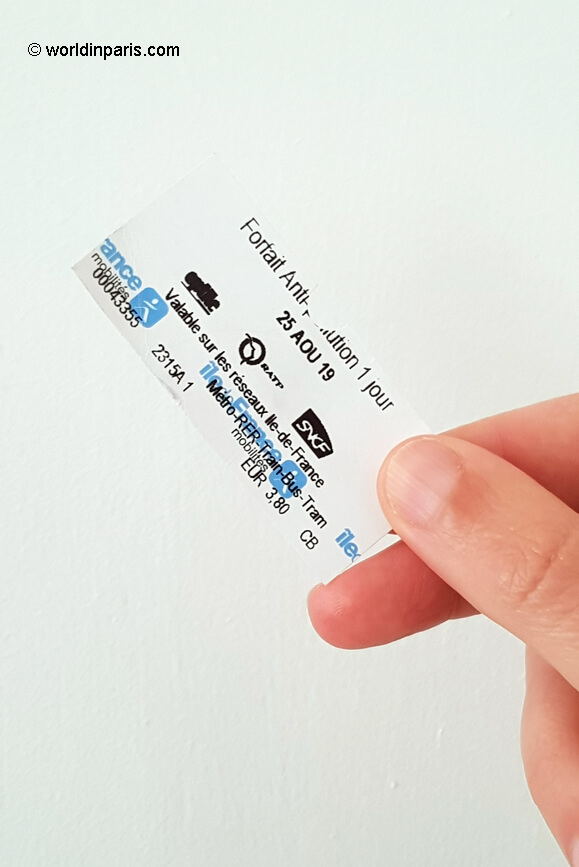
Does the air smell bad in Paris today? In the event of a pollution spike, the Metro of Paris offers a 1-day Anti-pollution Pass ( Forfait Antipollution ) with unlimited travel on all modes of public transport (except Orly Val) throughout Paris and Ile-de-France. This pass costs 3.90 € and is available online (via any Paris Metro app) and at any Metro station in Paris.
How to know when this special Paris Metro Day Pass is available? This information usually appears on the screens of all metro stations just before the metro automatic tripods. You can also check it online on the RATP website.
Weekend Metro Pass Paris for Youth
The Weekend Paris Metro Pass for youth ( Forfait Navigo Jeunes Weekend ) is a one-day travel pass limited to young people under 26. It can be used only on Saturdays, Sundays, and bank holidays from 12 am to 11:59 pm and for your choice zones.
This pass costs 4.70 € for zones 1-3 and 10.35 € for zones 1-5 and is available online (via any Paris Metro app) and at any Metro station in Paris.

5. Paris Metro Lines and Paris Metro Map
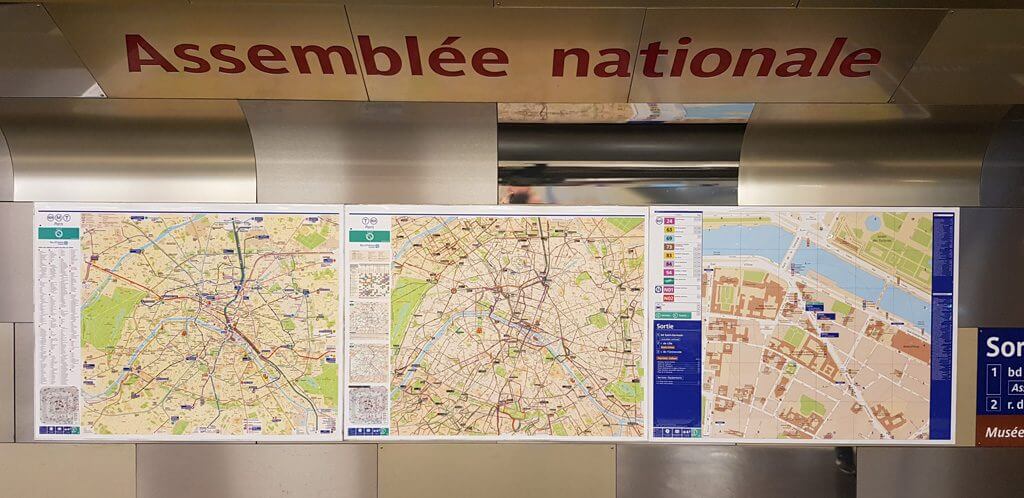
The Metro of Paris covers all the Arrondissements of Paris and some of the City’s surrounding suburbs. It is 220 km long, and it goes underground most of the time. There are 16 Paris Metro lines, numbered from 1 to 14, plus line 3bis and line 7bis. The Metro of Paris counts 302 metro stations, 62 of them with transfers between lines.
To find your bearings, you have different Paris Metro maps on each platform. The most useful maps for you are the Plan du Métro (Map of Paris Metro) and the Plan du Quartier (Neighborhood Map).
> On the Paris Metro Map , you can see all the Paris Metro lines with their corresponding colors, metro stations, and connections between them.
> On the Neighborhood Map , you can see on a larger scale the neighborhood streets where the metro station is located and all the exits for that metro station. One single metro station can have multiple exits, so if you are going to a specific address, have a look at this Plan du Quartier before leaving the metro and choose the exit closer to your destination point; it can save you lots of walking!
A (free) mini foldable map of the Paris Metro is also available at the Information Kiosks located at the metro entrance, and it is handy. On it, you can see the Paris Metro zones, all the metro lines, metro stations, and their connections. All the RATP apps have the Paris Metro Map included. You can also download a PDF version here for free.
6. Paris Metro Hours and Paris Metro Rush Hour
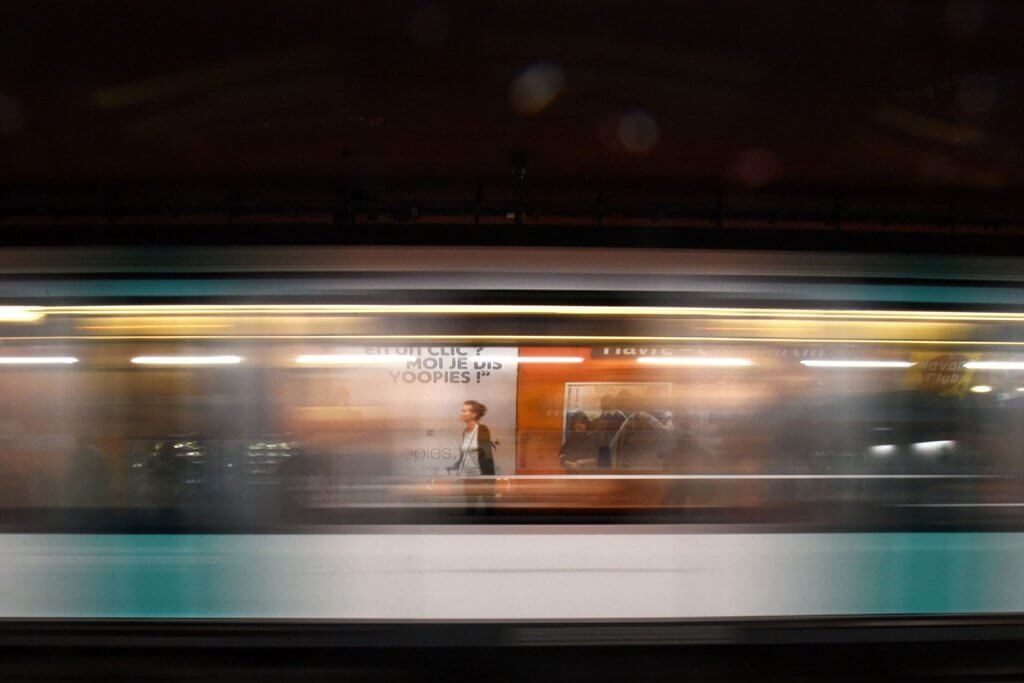
What are the Paris Metro hours? What time does the Metro close in Paris?
The Paris Metro hours depend on the day of the week. The Metro of Paris runs from 5.30 am to 1.00 am during the weekdays and from 5.30 am to 2.00 am on Friday, Saturday, and bank holidays.
Paris Metro Rush Hour
If you are using the metro to visit Paris, we recommend avoiding the Paris Metro rush hour, from Monday to Friday from 8 am to 10 am and from 5 pm to 8 pm. Traveling out of the Paris Metro rush hour means an easier journey, and perhaps you can also get a seat.
TIP: Check how to survive the Metro of Paris in the Summer
7. How to Use the Paris Metro – Top Local Tips
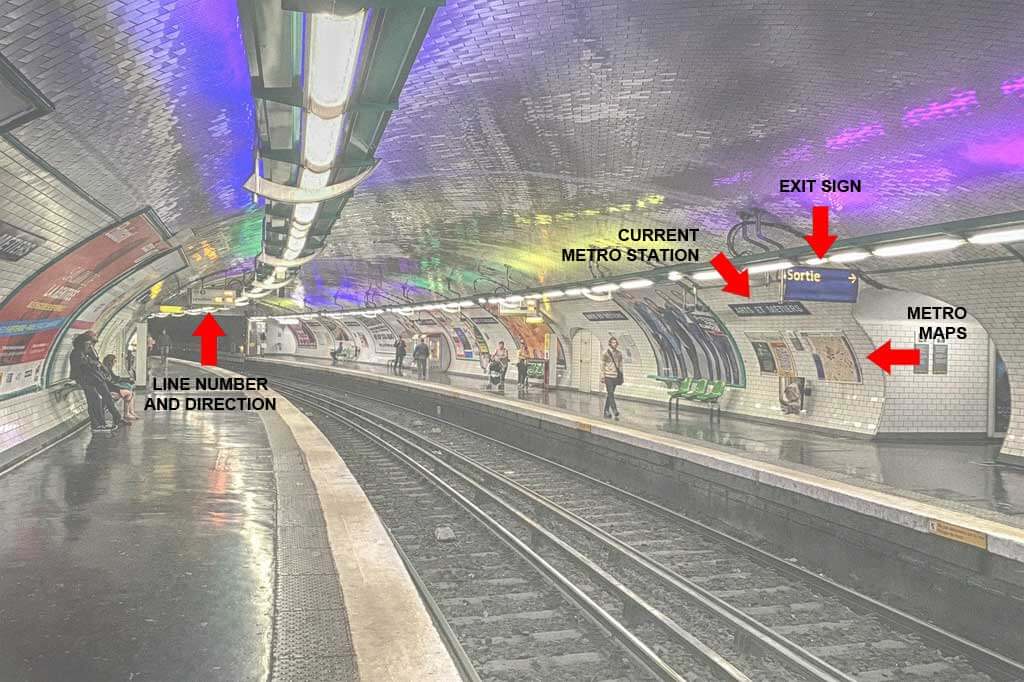
Download a Paris Metro App
The best way to navigate Paris by Metro is to download a Paris Metro app on your phone. I use RATP’s free app Ile-de-France Mobilités , available for Android and iPhone.
This Paris Metro app includes a Metro trip planner. The app has a Map of the Metro of Paris, and it calculates the best itinerary from A to B for you. Thanks to its geolocation function, it also shows the closest metro station.
With this app, you can also get live metro traffic news (current interruptions and maintenance works).
Know your Direction and Follow the Panels
Each Metro line has a specific color and a number. The panels on the Metro walls and the electronic panels on the platform show the line number and the direction (first station – last station). For example, if you take Line 2, you will see panels with Line #2 Porte Dauphine and Line #2 Nation .
Exits are called Sortie in French, and a single metro station can have more than one Sortie. To choose the right exit, look at the Neighbourhood Map, look for your destination, and take the closest exit to your destination.
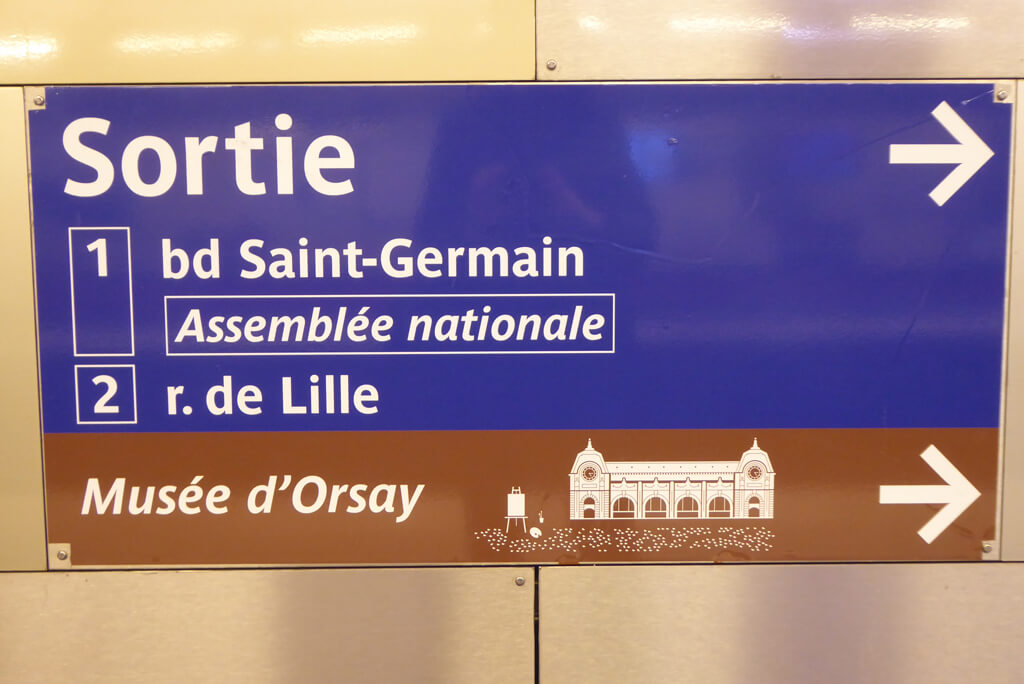
Metro stations close to tourist attractions always include a brown panel with a sketch drawing of that specific attraction. Follow the panel.
Avoid Busy Metro Hubs
Unless it is vital, avoid big and crazy metro hubs like Châtelet , Montparnasse, or Gare de Lyon . These stations can have up to 15 different platforms, and it might take a good 10 minutes to navigate from one line to the other.
We don’t suggest stopping at Châtelet-Les Halles ; the direction panels are placed so badly that I always end up turning around the same 2 or 3 pillars in the hall above. The only explanation for me is that the guy who placed all those panels drank a little bit too much wine that day!
Sometimes, Walking is Faster than Taking the Metro
Look at the map below with the walking distances between main metro hubs. In most cases, you need 30 min or less to go from A to B on foot.
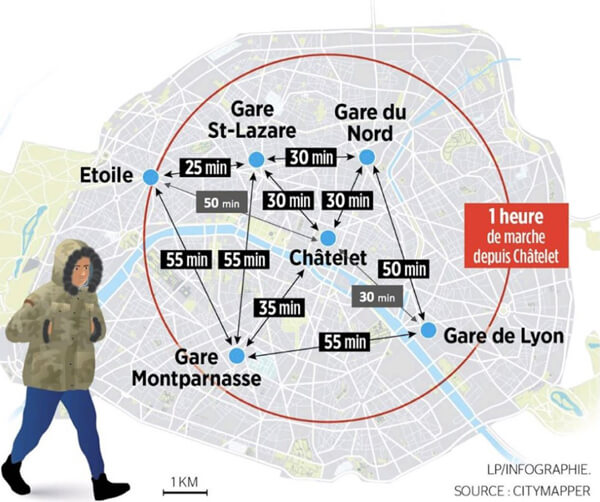
Here’s a more detailed Paris Metro Map with walking distances between metro stations. Sometimes it’s faster and more pleasant to walk in the open air than changing metro lines in Paris underground!
Check that Your Metro Station is Working!
The Paris Metro is currently undergoing huge renovation works to adapt its stations to people with disabilities. This means that some metro stations are closed to passengers for a certain time, the trains do not stop there, and you need to find an alternative itinerary.
You can check if the closest metro station to your hotel is open or closed for work on the RATP website .
8. Metro of Paris Etiquette
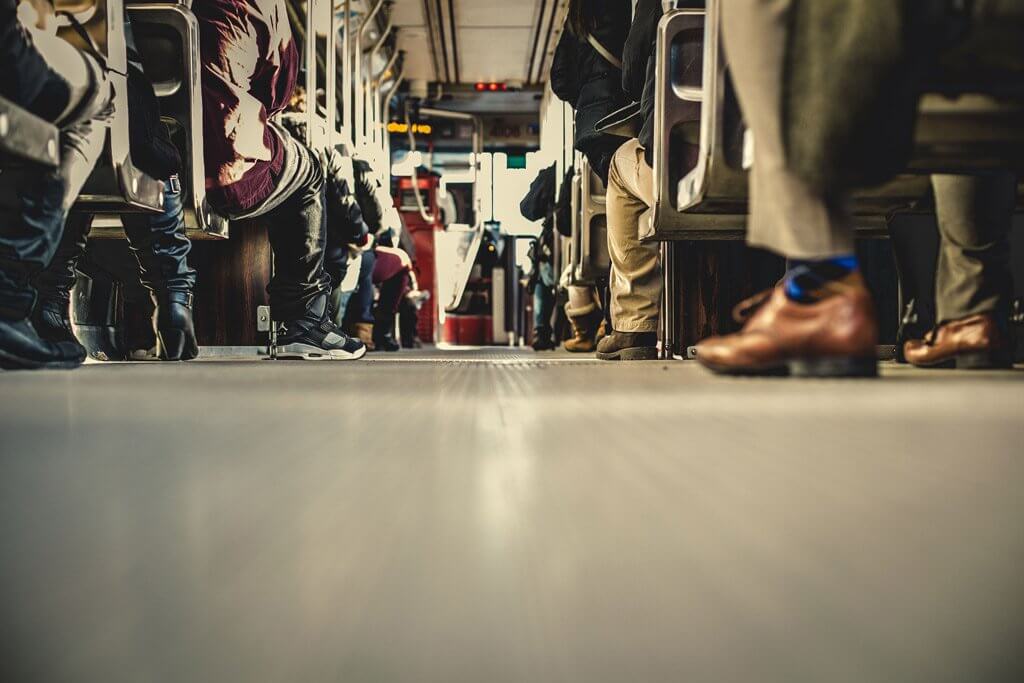
It’s true: Parisians have their own rules when they use the Parisian Metro! Published online, the Paris Metro Etiquette Guide lists “12 basic commandments” split into four categories: Helpfulness, Courtesy, Manners, and Politeness.
Just because you are not Parisian, it does not mean that you don’t need to follow the rules. When navigating Paris by Metro, there are some big “faux pas,” and, local or not, you should know them. Most of the rules are based on politeness and common sense, like:
> Smoking signs in the Metro are not pieces of art but bans.
> Mind your hygiene. Please, mind your hygiene!
> Assist elderly passengers or pregnant women with their bags and let them your seat if they don’t have one.
> Let passengers leave the train before stepping on it. OR if you are on the metro just in front of the door but don’t need to leave, please step out of the metro to let passengers leave. Then, enter the metro again.
> Avoid folding down seats when the metro is full. This is a HUGE passenger “faux-pas,” not appreciated by commuters (and they won’t hesitate to tell it to you clearly until you stand up!).
You will be happy to learn that Parisians are encouraged to be patient and helpful with lost tourists if only to relish their bad French privately: indeed, some Metro Stations like Boucicaut, Daumesnil, or Aulnay-sous-Bois are not that easy to pronounce in French 😉
Are you meeting other people in the City? In Paris, it is common to meet friends at the exit of a specific Metro station. But what happens when a metro station has many different exits? To avoid confusion, we always meet at Sortie #1.
Most Beautiful Metro Stations in Paris
The Metro de Paris, the second oldest metro in the world (only after London), has an interesting history and beautiful metro stations. Read the informative panels (in French) to learn about its history and some curious anecdotes about this part of Paris underground .
If you have some extra time, visit the most beautiful metro stations .
9. When Things Go Wrong
When using the Metro in Paris, check the information monitors with all metro lines’ status before taking the first train. If there is an issue with your Metro line or Metro stop, you can look for a plan B by checking the Paris Metro Map.
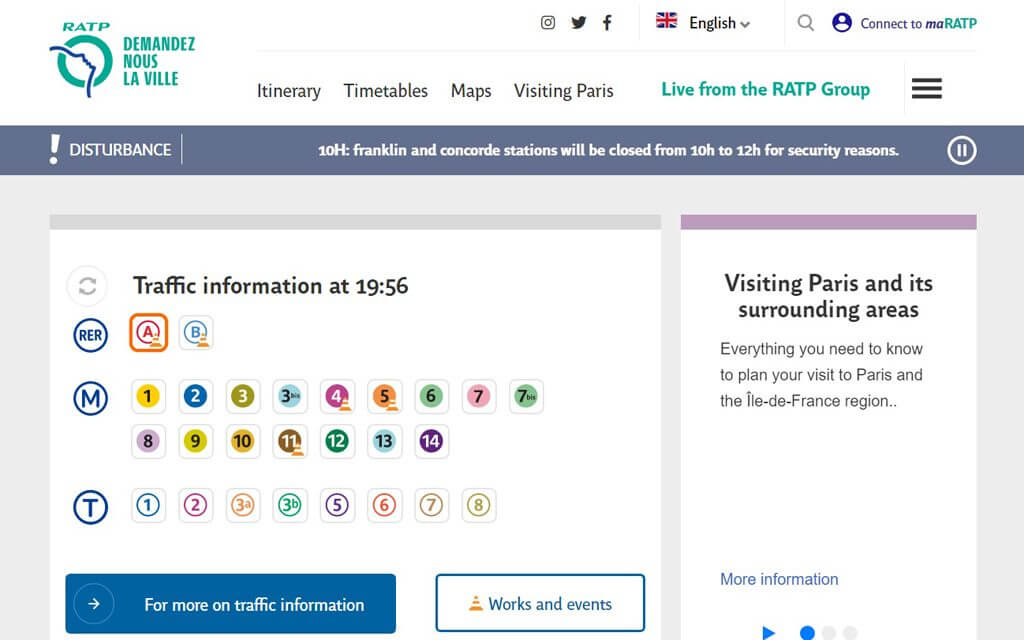
Metro’s Jargon
From time to time, you will hear some information coming from the metro loudspeakers, on the platforms, and inside the trains.
Some messages like “Beware of pickpockets” or “Please mind the gap between the train and the platform” are multilingual messages repeated in French, English, Italian, German, Spanish, Japanese, and Chinese. Other messages, instead, are only in French, and they are not that clear, even for locals.
What the heck are they saying? Should you worry? Here are the most common messages in French and what they usually mean:
> “Colis suspect” or “bagage abandonné”: abandoned bag or luggage, the traffic is interrupted until the police arrive and check the bag.
> “Panne de signalisation”: there is a technical issue like cable theft, degradation of a rail, or failure in the electrical system. This usually means traffic is interrupted or delayed
> “Incident d’exploitation”: this is a ‘jolly’ expression that can mean many things. It can come from infrastructure (referral problems) and external elements like alarm signals or people on the tracks.
> “Incident voyageur” or “malaise voyageur”: a traveler is considered to be ‘sick or ill’ if he suffers from heart problems, fainting, or simply hotshots. The metro driver must go to check his condition, so the train stops.
> “En raison d’incident divers, le trafic est perturbé, voir arrêté”: one of the worst messages that you can hear in the Metro in Paris because it means that many things are happening at the same time. Start thinking about a plan B.
> “Incident grave voyageur”: this is the worst message you can hear in the Metro. Unfortunately, most of the time, it means that there was a suicide somewhere along the line, and the train had to stop. Leave the train and look for a plan B.
10. How to Avoid Pickpockets in the Metro of Paris

Unfortunately, pickpockets are common in the Metro of Paris, especially along lines 1 and 9, with stops like Trocadéro, Louvre, or Champs Elysées.
Be careful not only inside the trains or platforms but also on the mechanical stairs. Thieves like busy mechanical stairs, especially when they go upstairs: they place themselves right after you, one step below you, which is the perfect position to open your backpack.
How to Avoid Being a Target for Pickpockets in the Metro?
> Try to stay as awake and aware as possible, especially in the most touristy areas.
> Don’t show valuable belongings like expensive cameras around your neck, fancy mobile phones, or jewelry.
> Since you enter the Metro, keep your backpack in front of you until you leave it.
> Consider an anti-theft shoulder bag.
> A money belt is always a good idea for tourists.
> If anyone spills anything on you, just refuse their help. If you were walking, keep walking.
TIP: explore Paris with an anti-theft backpack or an anti-theft crossbody bag for safe travels and peace of mind.
Read more about Getting Around Paris
Back to Homepage
Pin it now & read it later

Disclaimer: This post includes affiliate links, meaning I get a small commission if you make a purchase through my links. It costs you nothing more (in fact, if anything, you’ll get a nice discount) but helps me to go on creating incredible Paris content for you. I trust all products promoted here and would never recommend a product that isn’t of value. World in Paris is a participant in the Amazon Services LLC Associates Program. As an Amazon Associate, I earn from qualifying purchases at no expense to you.

About WORLD IN PARIS
Quirky parisian explorer with a preference for lesser-known sights, i am continuously looking for new ideas and tips to bring you the best of the city of light read more about me ., i am elisa, the travel blogger behind world in paris. quirky explorer with a preference for the local side of my city and its lesser-known sights, i am continuously looking for new ideas to enjoy the best of paris & around . do you want to go beyond the louvre museum or the eiffel tower keep clicking for first-hand information & my best tips learn more.
Single tickets and carnets
The traditional Métro ticket is a small piece of cardboard (formerly mauve, now white) with a magnetic strip that costs €2,10 . It's issued by RATP, the transportation authority for the Paris region, and at some point it will be replaced by electronic cards such as Navigo Easy (see below).

If you're traveling with a children, see the "Tips" section below.

You can also use single-journey tickets and fares on buses or trams, although you can't transfer between the Métro and RER and buses or trams on the same ticket.
Important: During and immediately after the Paris Olympics (July 20 - Sept. 8, 2024), fares are almost double the normal rates. See the Paris Olympics special fare table below for details.
Unlike T+ tickets, bus tickets purchased on board are good only on buses and trams (they also cost 40 cents more at €2,50 ).
Métro ticket machines accept coins and credit cards, but many machines don't take banknotes. If you pay by credit card, don't withdraw the card too quickly: It may take half a minute or longer for the machine to scan the card and process the transaction, especially if you're using a magnetic-stripe credit card from abroad.
Children under age 4 travel free. Kids from ages 4 through 9 pay the full adult fare for single tickets, but a children's carnet of 10 tickets is half price, so it pays to plan ahead.
Important: T+ cardboard tickets will remain valid for the foreseeable future, but expect to see fewer ticket machines as the RATP continues to promote electronic fare alternatives.
For details on the current generation of tickets and carnets , including what kinds of transfers are allowed, see the RATP's " T+ tickets " page.
Navigo Easy : a replacement for paper tickets

In June, 2019, the RATP introduced Navigo Easy , a rechargeable stored-value plastic card designed for tourists and other non-commuters who use the Paris public-transportation system.
Navigo Easy will eventually replace the traditional T+ tickets altogether, but you can purchase and use it right now.
To use Navigo Easy, you first buy a card for €2,-- from a ticket booth in any Paris Métro station. You then top it up with fares, which cost the same as today's existing paper tickets: €2,10 for a single ride,wih a big discount if you buy a carnet of 10 rides.
For now, Navigo Easy is just an optional alternative to T+ tickets, but the convenience of not having to carry a stack of cardboard tickets makes it worthwhile if most of your travel will be on the Métro--especially since T+ tickets are notorious for becoming demagnetized, which makes them unusable until a station agent runs them through an electronic device to fix them.
See: Navigo Easy guide (with step-by-step photos)
Money-saving passes
If you plan to use public transportation extensively, you may find it worthwhile to buy one of the passes described below. Or maybe not: As we point out under "Tips," a carnet of electronic tickets is simpler to buy and is likely to be cheaper if you don't spend a lot of time on trains and buses.
Paris Visite is an unlimited tourist travel pass that you can buy for one, two, three, or five calendar days. The "Paris Centre" version covers transportation in zones 1-3. For travel to zones 4 and 5 (including Charles de Gaulle Airport, Orly Airport, and Versailles), you'll need the more expensive "Paris and Île-de-France region" version, which covers all zones.
Children from 4 to 10 pay half-price (again, kids 4 and under are free), and Paris Visite offers discounts on boat cruises and certain other tourist attractions.
In addition to the Navigo Easy stored-value ticket card, the Paris transportation network offers Navigo Weekly and Navigo Monthly passes. (The weekly passes run from Monday through Sunday, and the monthly passes are for a calendar month.)
For more information on these and other tickets, see the RATP's Travel passes and prices page.
Where to buy passes: You can buy Paris Visite, Mobilis, and other passes at major Métro stations, RER stations, and railroad stations in the Ile-de-France region, including those at Paris airports. Paris Visite is also available at branches of the Paris tourist office.
Paris is a city that's best enjoyed on foot, so a carnet is likely to be your best value unless you have limited mobility, are pressed for time, or are staying a long way from tourist attractions.
Métro and RER ticket machines accept nearly all credit and debit cards, including American Visa and MasterCards that lack PINs.
Back to: Paris Métro
About the author:

After 4-1/2 years of covering European travel topics for About.com, Durant and Cheryl Imboden co-founded Europe for Visitors (including Paris for Visitors) in 2001. The site has earned "Best of the Web" honors from Forbes and The Washington Post .
For more information, see About our site , press clippings , and reader testimonials .

How To Use The Parisian Metro in 2024
A very common questions in my Paris Travel Group ( join here, it’s free! ) are about how to get around in Paris. But also, what is the best Paris Metro pass or travel card for the Parisian Metro.
And of course: how to use the Metro in Paris in the first place. I genuinely understand that public transportation in Paris can be confusing.
It was for me as well. But after living in Paris for almost 20 years, the Parisian Metro plan is imprinted in my brain, and I am here to help you out.

Salut, I am Lena – travel planning expert and parisienne since 2006 🩷
If you purchase through links on this site, I may earn – at no cost to you – a small commission. This helps me cover my costs and keep my website running. Thank you so much for your support 🙂 Learn more
Hence, in this article, I am sharing everything you need to know to ride the Parisian Metro confidently, how to pick the best Metro ticket for your situation, and how to pay for the Metro in Paris.
NEW : updated information regarding Metro prices during the Olympics Games in Summer 2024 at the end of the article.
NEW May 2024 : No need for a physical Navigo Card anymore if you have an Android or iPhone. Just download the App Île-de-France Mobilités from the app store, buy your tickets right on your phone, and use your phone to validate your ride at the gates.
Every user needs their phone. If you don’t have a smartphone, you need to buy the physical Navigo Card for €2, read more below.

Paris Metro Tickets: THIS is the Easiest Solution
Before explaining the Parisian Metro Ticketing System in all details, here’s the ticket option that suits the needs of most tourists.
➔ ➔ Physical Navigo Easy Card (if you don’t have a smartphone)
- Go to the RATP ticket counter and buy a Navigo Easy Pass for €2 (one pass per person)
- Ask the clerk to top it up with a bundle of 10 tickets for €17.30. Alternatively, use the vending machines
- Recharge with another bundle, or single tickets, if needed.
- If you visit Disneyland , Versailles, etc., buy a destination ticket at the station for €3 to €5
➔ ➔ Navigo Easy Card App on your phone
- Download the App Île-de-France Mobilités (one metro user per phone)
- Top it up with a bundle of 10 tickets for €17.30.
- Add it to your Apple or Google wallet and use your phone to validate your ride (works up to 6h if your phones run out of charge)
- Recharge with another bundle, or single tickets if needed
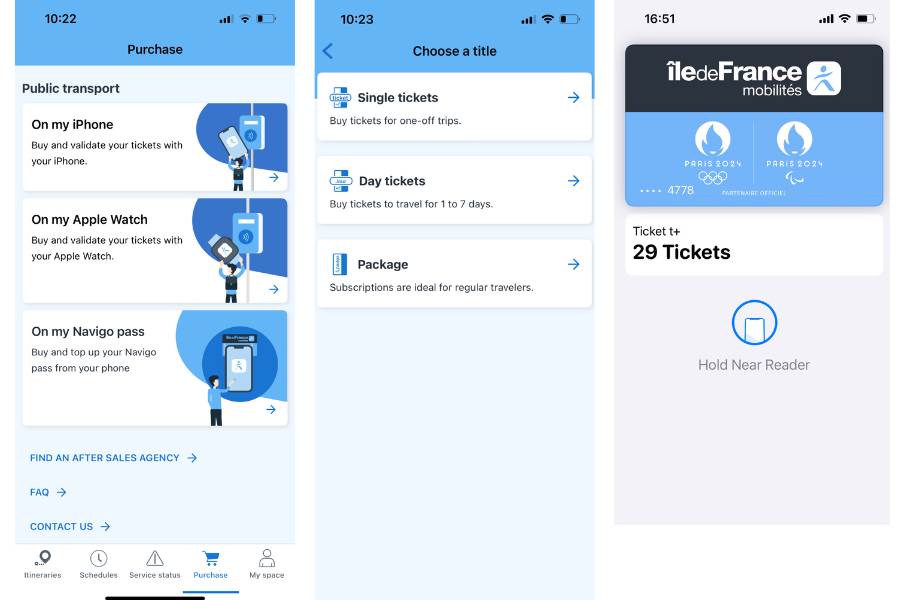
The Parisian Metro – The 3 Big DONT’S
Let’s start with the most important, so you don’t miss it even: Top 3 things you should know to avoid a fine .
If you come across someone who complains about getting fined on the Parisian Metro, it’s usually because of one of these three mistakes:
- They trashed their Metro ticket before they left the station
- They bought a kid fare for a 10-year-old child – the reduced fare is only for children until 9!
- They traveled on a simple ticket to Versailles or Disneyland
For further information and a detailed explanation on how to avoid fines on the metro, please read this article: 6 Reasons Tourists Getting Fined on the Paris Metro

Tickets and fares for Public Transportation in Paris
The first question everyone asks who plans to use the Parisian Metro is “What ticket do I need for the Paris Metro” ?
While I think that 10 ticket bundles are often the best solution, already because you will take the Metro less than you think. Paris is quite small after all.
But as there is never a one fits all solution, there is, once you dig into the details, no simple answer. It heavily depends on what your plans are.
For tourists, these tickets are interesting The single fare ticket, the day pass, and the week pass.
- single fare ticket+ €2.15 (Navigo Easy Card, Mobilités App, paper strip)
- bundle of 10 ticket+ €17.35 (Navigo Easy Card, Mobilitiés App)
- day ticket €8.65 (Navigo Easy Card, Mobilitiés App, paper strip)
- week pass €30.75 (Navigo Découverte Card, Mobilités App, paper strip, valid Mon-Sun)
- Destination Tickets (Paper Strip) for destinations outside Paris (Disney, Versailles etc.)
Prices are subject to change. Source: Île-de-France Mobilités
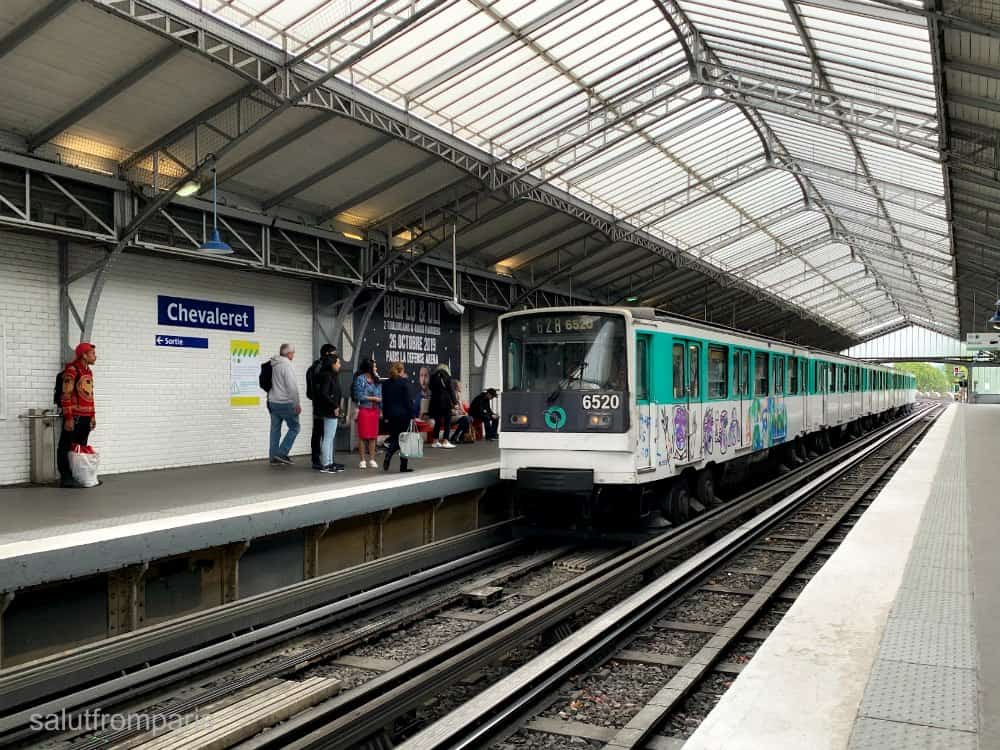
Single-fare Tickets for the Metro in Paris
The single-fare tickets are the most standard option for the inner Paris public transportation services. You simply buy a ticket and validate one ticket per trip and person.
You can buy them as single tickets, or in a bundle of 10, which is significantly cheaper.
All tickets are purchasable for different zones – the further you are moving away from Paris, the more expensive gets your ride.
Paris Metro Tap to Pay : You can’t pay for the Paris Metro directly with your credit card. You are required to obtain either a Navigo Pass, download an app, or buy a paper ticket at the vending machines.
You can buy the tickets for the Navigo Pass with your credit card at the machines, of course.
Good to Know: You can’t split the Navigo Card up between several passengers. It’s always one card or device per person, and each person in your group needs their personal card. Children included.
If they don’t have a smartphone yet, you can buy a Navigo Pass for 2€ at every Metro Station.

How much does transportation in Paris cost?
The Base Ticket: the ticket+ for Paris
The base ticket for the Parisian Metro is a ti cket t+. It costs €2.15 (€1.73 if you buy a bundle of 10) and is valid within Paris and all adjacent suburbs.
You can change Metro lines as often as you want, as long as you are not exceeding 2 hours and don’t leave the station. It is also valid on the RER, bus and trams within Paris.
You can purchase a single-ride ticket or a bundle of 10 on the ticket machines that you find in every metro station and load it on your Navigo Easy travel card.
Alternatively, you can buy your travel pass through the Île-de-France Mobilités App and use your mobile device to validate it at the turnstiles.
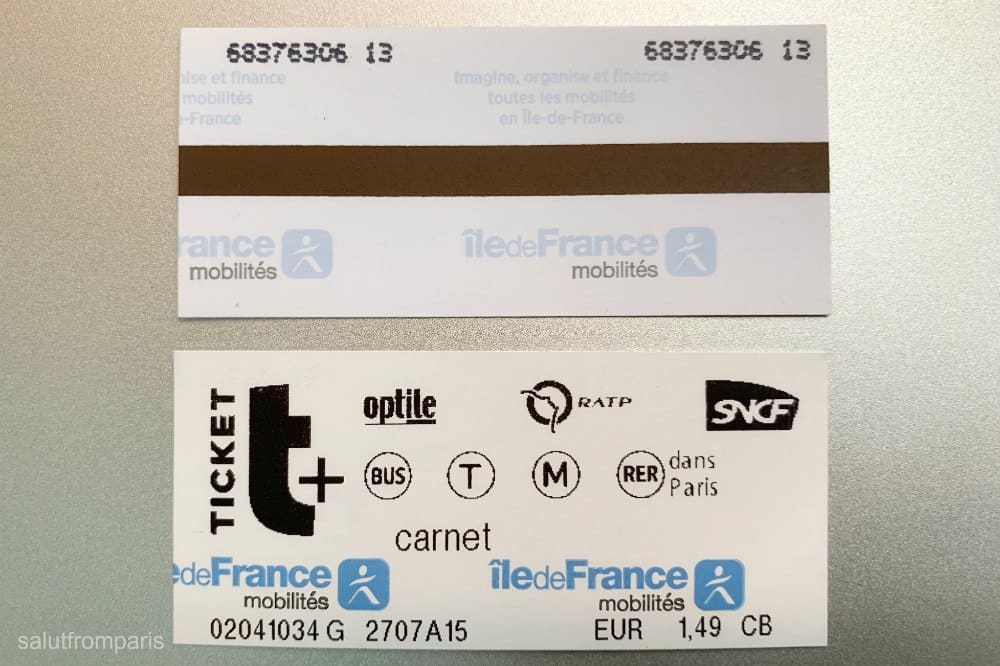
The good ol’Paper Strip – The Classic Billet
If you’ve been to Paris already, you probably remember these famous paper strips. Well, they are slowly but surely becoming history.
At the time of writing, single ride tickets+ are still available in paper form for occasional users. However, the practical and cheap bundle of 10, that you could split up between your travel party, is gone.
You now can buy the bundle, the carnet , only for mobile devices or your Navigo card.
The carnet is still very interesting, as you save 20%: 10 rides are only €17.35, while you’d be charged €2.15 if you’d buy a single ride. But you cannot split your rides up anymore.
Each member of your travel group has to buy their own carnet on their own device, mobile or Navigo.
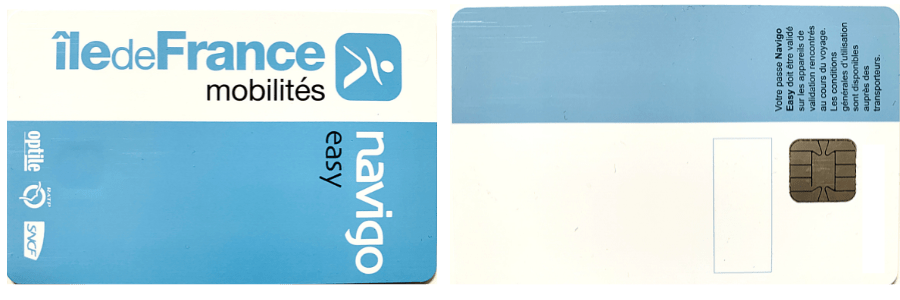
Are kids riding the Parisian Metro for free?
Only Kids under 4 are traveling for free on Paris public transportation. Kids of the age of 4 to 9 (not 3 anymore, and not yet 10) are eligible to travel at a reduced fare of 50%.
Reduced fares are also available as a bundle of 10 (carnet). Children need their own Navigo Easy Card.
Are Seniors paying less on the Paris Metro?
Seniors in Paris are paying the full price on the Metro. The ticket + tarif reduit is only for children and certain groups, but not for Seniors.
Hence, if you are over 65+, you have to pay the full price on the Metro. However, you do find senior rates at some museums and sights.
Paris Day Travel Passes
You also have the option to purchase a Paris Metro day pass for the public transportation system.
This option allows you to take as many rides as you like within one day . The pass costs 8,45€ for zone 1-2 and is valid from 00-24h.
Hence, if you buy a pass at 10 am, you can ride for free until midnight, not until 10 am the next day.
The day ticket is available with the Pass Navigo Easy, the App or as paper ticket.

The big advantage of a day pass is, of course, that you don’t have to think at all about any further costs when riding the Parisian Metro.
But you should consider that it requires 5 rides for your day pass to be beneficial (compared to the 10 ticket carnet). From my experience, 5 rides are quite a lot for one day in Paris .
That’s because Paris is smaller than you may think. You will rarely need more than 3 or 4 rides a day.
If you consider purchasing a day pass, keep in mind that a trip to Versailles for example, requires a higher price class. At the time of writing, a day pass that includes Versailles costs around €13.
Week and tourist passes for the Paris Metro
If you stay a few days longer in Paris, a ticket that is valid for longer period of time could be interesting for you. You have two options:
Navigo Semaine – Week Pass
The Navigo Semaine card is a transport pass for 7 days and comes at a very interesting price. It allows you to travel in all 5 zones, hence even to the airport, to Disneyland and Versailles for only €30.75.
But all good things come with a catch: the Navigo Semaine is not obtainable at all stations and is only valid from Monday morning to Sunday night. You can’t pick your dates.
As a tourist, you need to purchase a Passe Navigo Découverte for €5 as support. However, you can also use the Navigo App now.
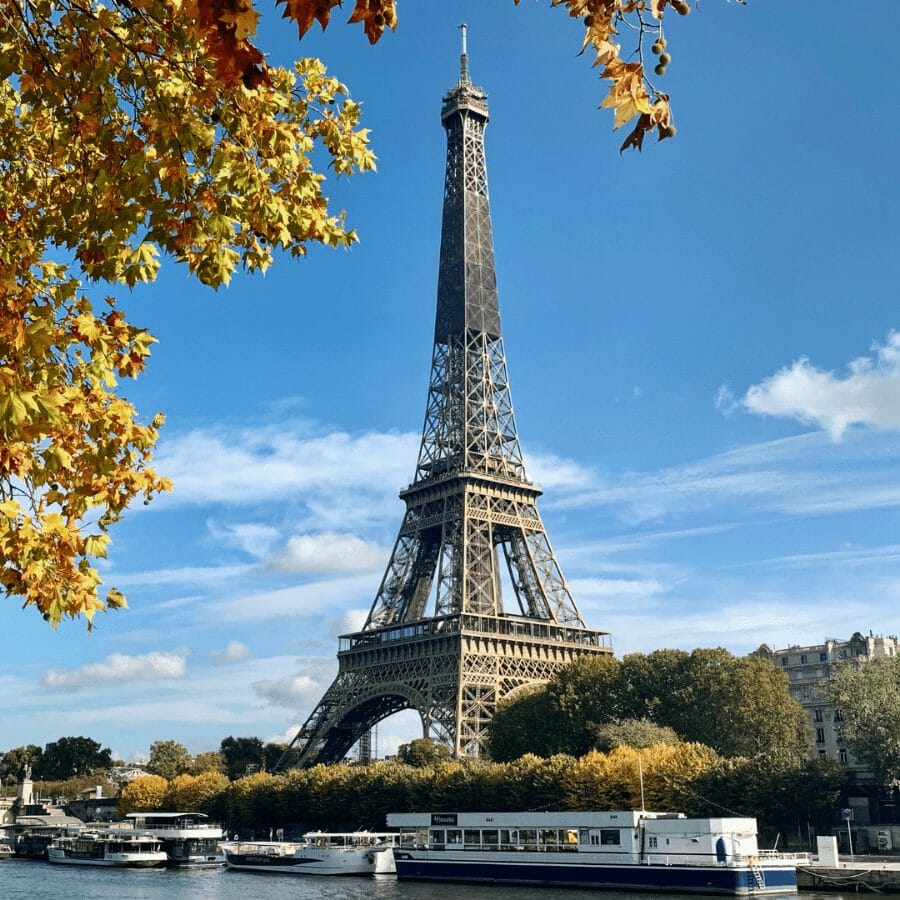
Paris Visite Passe: Tourist Pass for Public Transportation in Paris
The tourist pass covers a maximum of 5 days, and you can choose both, the dates and the zones that you require.
Even though the flexibility is a strong point compared to the week pass, the Paris Visite Pass is unreasonably expensive. It just makes no sense if I might be that honest. Don’t buy it.
For example: The Paris Visite Pass for 3 days including Disney, Versailles and Airport costs 62.30. If you’d buy a 3 day passes, you’d pay €61.80. Not much of a different, but noone who visits Paris uses the Metro that excessively, that 3 all-zones day passes would be worth it.
Even if you’d travelled every day outside Paris, you would still need to make 5 additional rides inside Paris.
Conclusion – Which Metro Ticket is the Best for Paris?
For most Paris visitors, single fare tickets are the best option . Buy them in a bundle of 10 to save money, and get an additional destination ticket if you want to visit Versailles or Disneyland.
If you know that on a particular day, you will use the Metro extensively, you still could get a day pass, to cover the costs.
It’s convenient and it requires zero preparation. Just download the app and buy your ticket right on your mobile device. Alternatively, you can get a Navigo Easy Card upon arrival and top it up on the vending machines.

The single fare tickets are your best option if:
- your accommodation is in Paris or adjacent suburbs ( click here to see a list of good budget hotels in Paris )
- you plan to leave Paris only once or twice (for example to visit Disneyland or Versailles) on your own and are not taking one of the really well organized day tours from Paris
- you are not having reduced mobility and walking is no problem
Compared to single-ride tickets, you need to take the Metro too often to benefit from a day pass. The cheap week pass is, however, not easy to get and not flexible at all when it comes to dates. The Paris Visite Pass is unreasonably expensive.
How to use the Metro in Paris?
Now that you know the essentials about the different Ticket options for your Paris vacation, let’s move on and see where to buy them, how to validate your tickets and everything you need to know to travel around Paris with confidence.

Where to buy the Tickets for the Parisian Metro?
The easiest way: Download the app Île-de-France Mobilités and buy your Metro tickets through it.
You also can purchase your Metro ticket at ticket machines that are available at every train, tram, and metro station. The ticket machines are multilingual . Most train and metro stations are also having an RATP info point, in case you require help.
Note : RATP employees are always wearing green uniforms. If someone approaches you without this uniform and offers help, watch out. Even if they are wearing a badge and acting professional. If you need help, you get it at the RATP Info Point.
It became a common scam to sell already used or wrong tickets to tourists. You can read more on Paris tourist scams here .
Good to know: Tickets to Airports, Versailles or Disneyland are available at the vending machines in every station.
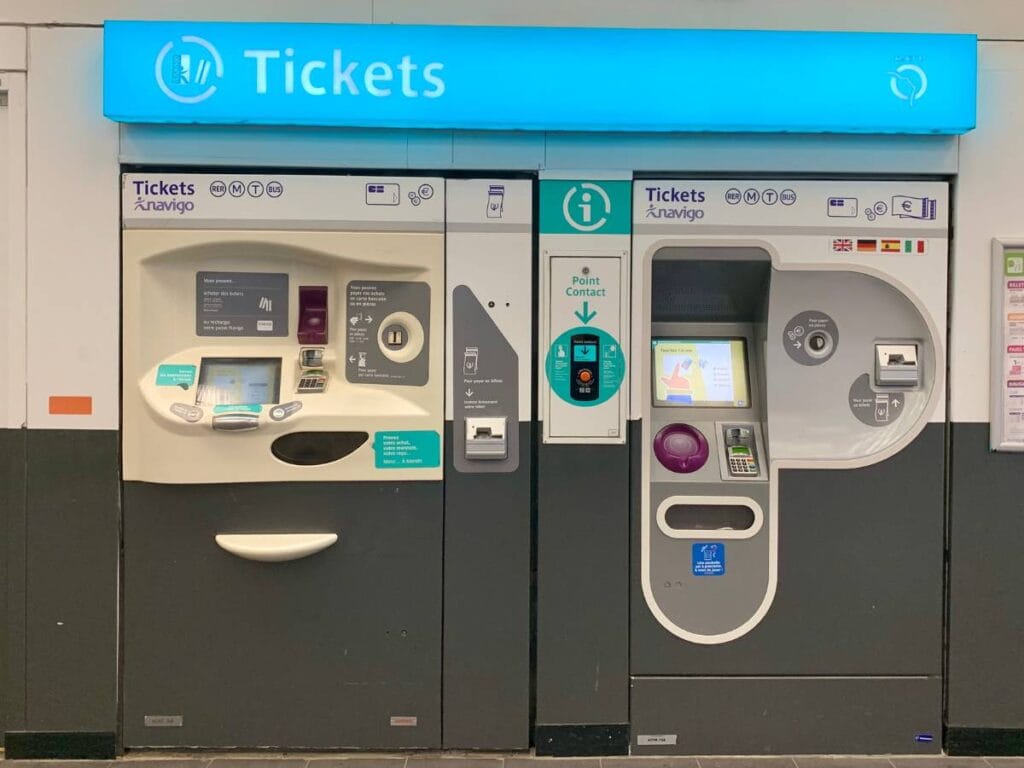
How to use the Vending Machines
If you are buying a ticket at the ticket machine, you will be prompted to choose your language first. Makes it easier, doesn’t it?
However, while most machines are equipped with a touchscreen, some older models have a kind of role that helps you scroll through the menu.
The menu is pretty intuitive and self-explanatory. Many popular destinations like airports or Disneyland are preselected.
How to pay for the Metro in Paris?
When you are in Paris, you can’t pay for the Metro with your credit card. You need to get a Navigo Pass, either a physical or a digital one on your phone, and top it up with the ticket of your choice.
You pay for the tickets at the vending machine with a credit card (American Express is not accepted) or cash. At the time of writing, you can pay for the Paris Metro only at some stations contactless with your credit card. It otherwise requires your pin code.
If you are using your smartphone to buy tickets, you can pay by Apple Pay, Carte Bleue, Visa or Mastercard.

How to validate a ticket on the Parisian Metro?
Buying your ticket is not enough, you need to validate it before each ride. If you are using a paper ticket, you need to pass it through the slot on the right side of the turnstile.
If you own a Navigo Découverte or Navigo Easy Pass, simply place your card over the purple reader to unlock the turnstiles.
If you are using your phone as a device, add the ticket to your Apple or Google wallet and hold it against the card reader. Even if your phone is off charge or off, you can still use this functionality for up to 6h. (I tried it after a few hours and it works)
Good to know: If the flap doors are open, still validate your ticket. If you get controlled without a validated ticket, you’ll receive a fine.

Using the Metro in Paris with luggage or strollers
If you find yourself in a situation where it’s not possible to use the turnstiles or flap doors, don’t worry.
Every metro station has a gate, that can be opened on request by pushing a button. Just don’t forget to validate your ticket, though!
Is the Metro in Paris barrier-free?
Unfortunately, no. Not at all. Many stations were built more than 100 years ago, and barrier-free access wasn’t on the radar of anyone back then.
Some stations got reequipped with elevators during the last few years, but it’s by far not enough to rely on the Metro as public transportation if you need barrier-free access.
Solely line 14 is completely barrier-free. However, the good news is, that Paris has a great bus network as well and all buses are barrier-free.
How to read the Metro plan?
At the first glimpse, the Metro plan does look indeed like a huge mess. But it’s actually straightforward to understand.
Each Metro line crosses Paris from one side to another and back, and consequently has a starting and end station. Just check in which direction your destination lays and you’re good to go.
For example : If you are at the station at Hôtel de Ville and you intend to visit the Arc de Triomphe, you need to take line 1 direction La Defense. If you want to visit the Bastille, you would need to board Metro 1 as well, but heading in the opposite direction of Château de Vincennes.
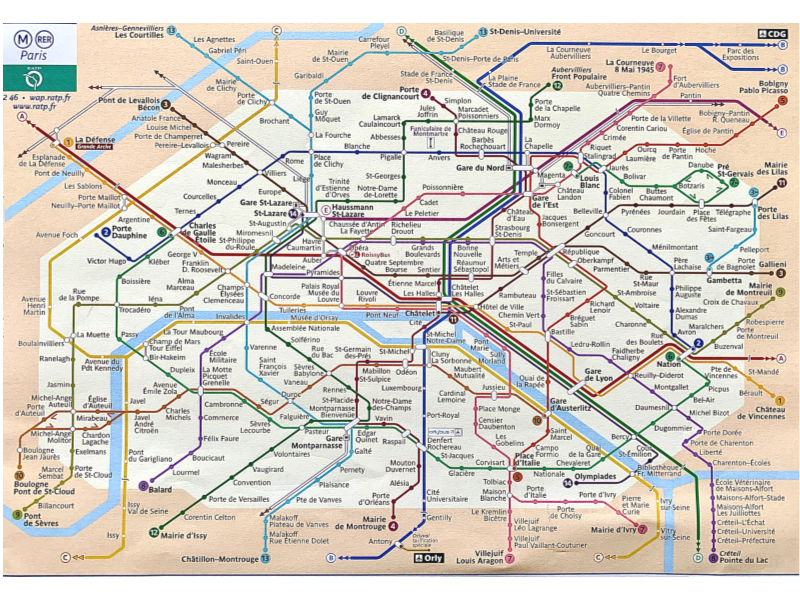
It helps a lot that each Metro stairway features a signpost that indicates exactly which station this very line and direction will serve. Each Metro line has its own platform – contrary to Berlin, for example, where several lines stop at the same platform.
A good piece of advice is to get familiar with the plan before traveling to Paris. Check which Metro station is the closest to your accommodation, how to get from there to the Eiffel Tower etc. and you will see that it quickly makes sense.
You can download the plan here . If you prefer the paper version, you can get one for free at every Metro station.

Safety in Paris’ Public Transportation
I read very often that people are worried about their safety when traveling to Paris . One of the main concerns is getting scammed or robbed while riding the Metro.
There is a certain risk and since a couple of years, reports of pickpockets on the Metro are rising. Especially on social media.
However, the Parisian Metro transports well over 4 Million passengers per day. The % of people experiencing issues is close to 0.
Paris ranks just behind London and Malmö, Sweden in the international safety ranking and this data includes public transportation.
Parisians take the Metro at all times. If you board a train at 23h, you find teenagers, couples, elderly people, sometimes families and many are indeed traveling alone. it’s not a dodgy or creepy place, but well lit and rather clean.

Things to keep in mind to stay safe:
- take care of your belongings and be conscious about them. Don’t carry your bag just above your shoulder, but hold the string. Show that you’re wary.
- Try to avoid using your phone. It can happen that someone grabs it and runs just at the very moment the doors are closing.
- If there is a safety announcement about pickpockets, DO NOT reach for your wallet. Someone might check for exactly this reflex to know where you keep it.
- Don’t get distracted.
Other Means of Public Transportation in Paris
If you are traveling to Paris, the Metro is the most obvious public transportation to take. However, there might be many reasons why this is not possible or appealing to you. Luckily, there are other means of public transportation that belong to the RATP network.
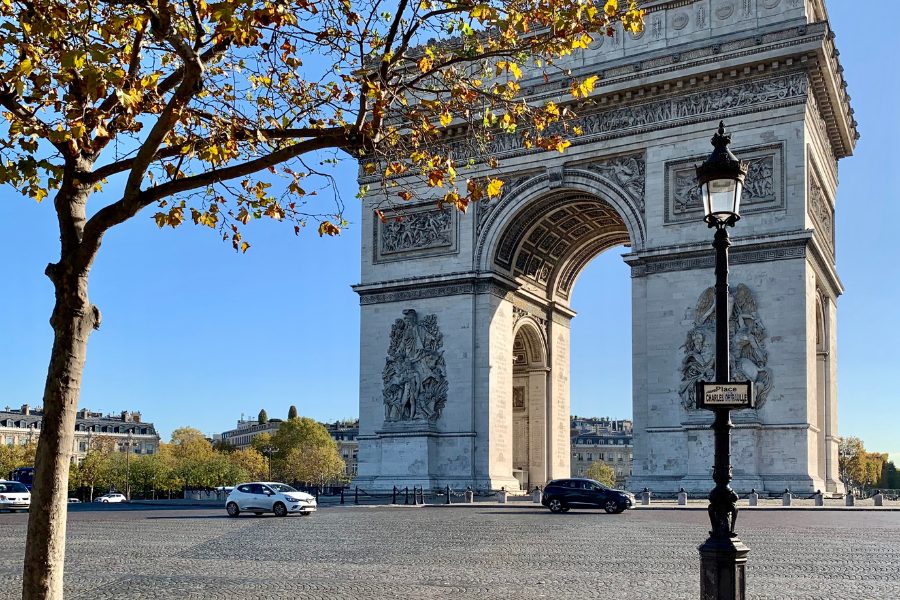
What does RATP stand for ? Régie Autonome des Transports Parisiens , Autonomous Operator of Parisian Transportation. RATP is your point of contact and the operator of every sort of public transportation within the Paris region.
Which Ticket for Public Transportation that is NOT the Metro?
Luckily, there is no different ticket needed. No matter what kind of public transportation you choose, the ticket remains the same.
It just might vary depending on the distance or the zones, but that’s about it. This applies especially to buses and trams.
Tickets for Buses and Trams in Paris
One ticket t+ is valid for 90 minut es while using buses and trams . You can transfer between both services, but you need to revalidate your ticket when boarding a new vehicle.
Exception: If you purchase your ticket on the bus , you can’t make a transfer. The tickets sold onboard are only for one bus trip without transfer.
Since 2021 you can buy your bus ticket by SMS. Simply send an SMS with the text BUS+Number to 93100 , and you receive a ticket by SMS.
It costs €2.50, and counts only for the bus trip, not for transfers.
Example: If you are on Bus 26, send BUS26 to the number 93100, and you’ll receive your ticket on your phone.

RER (Suburb train)
The RER is much like Paris Metro, but a little faster and with fewer stations. However, the RER is mostly a suburban train that connects Paris with surrounding cities. If you want to visit Versailles, for example, you would take the RER C. Disney is served by RER A.
If you are not using a travel pass that includes all zones, make sure to purchase a destination ticket at the vending machine at the station. The ticket+ is not the correct ticket for trips outside Paris.
Paris and its surrounding are divided into 5 zones. You need to purchase a ticket for all zones that you cross on your way.
But don’t worry too much about it, if you are at a ticket machine, you can simply click on “Ticket Île-de-France” ( Billets Île-de-France ) and pick your destination. You will obtain a station-to-station ticket or destination ticket , that covers automatically the appropriate number of zones.
Paris by Bus
Buses are running everywhere: inside Paris, outside Paris, from Paris to suburb, and from suburb to suburb.
Like for the Metro, you need a Ticket t+. You can transfer with the same ticket from bus to bus or to tram, but not to the Metro or RER, which would require a new ticket.
If not necessary, (Busses are barrier-free), I’d recommend avoiding them during a short-term stay. Schedules and maps are rather complicated and due to the Parisian traffic, they can be really timetaking.

Noctilien Night Buses
To fill the gap between the last and first Metro/Tram/RER, night buses are operating in Paris and connecting the city with the greater Paris area.
Noctilien buses are the cheapest way to get home after spending a night out in Paris , as you can board them with the usual ticket t+.
Just keep in mind that your fellow passengers also had a long night out and might be everything but sober.
Taking the Tram in Paris
The Tramway is relatively new in Paris and is built roughly as a circle around Paris, more or less parallel to the freeway.
To board the tram, you need a ticket t+. With one validated ticket, you can transfer from tram to tram or from tram to bus, but you need a new ticket to transfer to Metro or RER.
Metro & Trains during the Paris Olympics in 2024
In November 2023, it was announced, that for the month of July and August, when Paris is hosting the Olympic Games, the prices for public transportation will be augmented. Here’s what you can expect:
Voilà, the Parisian Metro explained – hopefully in an understandable way.
If you need any clarification, don’t hesitate to join our Facebook community . It’s a great knowledge hub with many experts, happy to help you out. Join here today for free .

Parisienne since 2006 🩷
Expert in: Parisian Life &
French Culture, Travel
Planning, Crochet & Food and Drinks
Join me on Facebook for updates and news about Paris.

Must Have Paris Travel Essentials
International Travel Adapter

Order here from Amazon
Portable Charger for your Phone

PS: Check out these posts, they will help you plan your trip to Paris
- 20 Arrondissements in Paris (Quick Guide + Map)
- Paris hidden gems: 80+ well kept secrets you shouldn’t miss
- What NOT to do in Paris -23 (costly) Paris Mistakes you need to avoid!
- 14 Hotels with stunning Eiffel Tower views- for (almost) every budget!
- Your Perfect 2 Days in Paris! Itinerary & Insider Tips
- 5 ways to get from Charles de Gaulle airport to Paris – THE complete guide!
- Scams in Paris! How to avoid the most common cons
FAQ: How to use the Paris Metro
You need to purchase the travel card Navigo at the station and load it up with the tickets of your choice. Alternatively, you can also get the App Île-de-France Mobilités that not only serves as a travel planner but also as a ticket device.
You can purchase your Metro ticket with a credit card, but your credit card can’t be used directly at the barriers to entering the Metro.
The Metro is as safe at night as by day and is always heavily used.
A Metro Ticket for a single ride costs 2,15 € in 2023. A bundle of 10 tickets costs 17,35 €.
You use the roll to scroll up and down the menu and pick the ticket of your choice. Most popular picks are single-ride tickets, bundles of 10, and destination tickets, where you choose your destination station outside of Paris. To charge your Navigo pass, place it on the purple field, so the machine can read it.
You place your Navigo Carte on the card reader before the turnstiles and wait until it “beeps”. You can pass then through the turnstile or gate.
Pin it now – and find it back later!

Similar Posts

Paris by Car: Parking, Crit’Air & Tolls – Local Driver Tips

Scams in Paris: 13 Top Tips to Avoid Common Cons


From Disneyland to the Eiffel Tower – How to Get There Best

How to get from Paris to Disneyland

How to get from CDG to Disneyland Paris? (5 Options)

5 Ways to Get from Charles de Gaulle Airport to Paris – THE Complete Guide!
18 comments.
Hey, I will be in Paris this year so perfect moment for this read! Thank you so much for all the helpful insights.
This is the kind of posts I like to read (and write), where you can get all the information you need to move around or plan something/your stay/etc before even getting there. Pretty good post, I may say.
thank you! 🙂
Shame on me I have not yet been to Paris. But, when I do, this will come in very handy. Public transportation is a minefield…
Oh my gosh, thank you! When I was in Paris with my husband, there were several times we were just baffled trying to figure out the system One of the things that tripped me up was RER. Because I couldn’t figure out what it was, we avoided taking it our first day – when it would have been better for us. Pinned this!
Thank you!!! Glad you find some value in it and sharing it around! 🙂
I must say Paris is one of the best cities for well-connected local transport. Since its so large in size, one does end up walking A LOT despite taking the metro or the bus from one spot to another. And not to mention the long distances between metro lines inside the stations 🙂 But its all very convenient. And enjoyable.
oh I am sure you talk about Montparnasse when thinking of long distances between Metro lines! We try to avoid that change by all means haha 😀
I will never get tired of reading about Paris. But all glitz and glamor of Paris comes with the super expensive transportation if hired privately. So, this post on public transportation and all teh tips you have mentioned ( especially the one about red and green indicators after parking the bike) would definitely help any one willing to explore the city on budget.
yeah, getting around privately is really expensive! We often use a mix of public transportation and Uber
A very useful post for everyone who want to get acquainted with the transport system of Paris city. You have listed dowm every single useful information regarding the topic and I can see how much effort you taken. I usually take up metros and buses rather than taxis as its very economical but as there’s Uber in the city I sometimes just go for it.
awww thank you for your kind words; I really appreciate it <3 the combination of public transport and Uber is perfect for us, too... especially when going out 🙂
It’s so nice that the metro runs late on the weekends! Also, good to know that buses are a bit complicated so not that great as an option for short term visitors. You’re article on all transport options is very thorough and complete! A great guide!
thank you <3 🙂
Any ideas about Accessibility for a wheelchair?
Hi Mona, sorry for my late reply, I simply missed your question 🙁 Paris is not really barrier free, unfortunately, and many (most) Metro Stations are not equipped with elevators. It’s probably easiest to get around by Bus. However, some Metro stations do have elevators, maybe this page helps: https://parisbytrain.com/map-paris-wheelchair-reduced-mobility-accessibility-metro-rer-bus-tram/ best, Lena
Comments are closed.

What's On in Paris
Performances.

- Christmas in Paris
- The Eiffel Tower
Monuments in Paris
Historic churches, history museums.
- The Louvre Museum
- Musée d'Orsay
The Top Paris Museums
Artist museums, more paris museums.
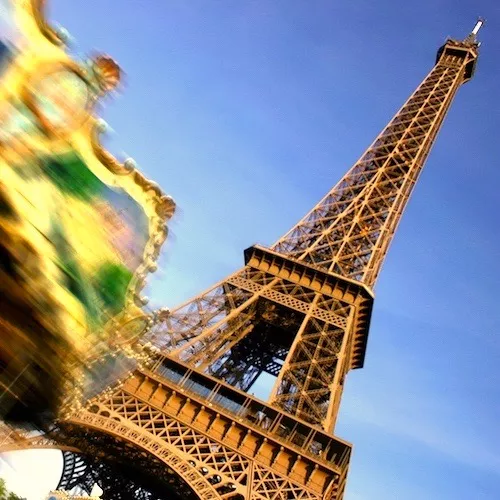
Eiffel Tower Skip-the-Line
The 6 essential day trips, 10 more iconic day tours, what to do in paris, seine river cruises, night in the city of light, paris city tours, walking tours, your own private paris.

- Romantic Dinner Cruises

Where to Stay in Paris
Small hotels of paris, top hotels near…, preferred 5-star hotels, the palaces of paris, affordable hotels.

The Foods of Montmartre
Food & wine activities, the foods of paris, memorable paris dining, best paris restaurants, paris restaurant guide.
- Bistros & Brasseries
Top-Rated Restaurants

- Visit the Champagne Region
Paris Attractions
You ask, we answer, visiting burgundy, paris miscellanea, top ten lists, unusual paris sights, paris gardens & parks, the paris explorer.

- What's On When You're Here
Airports & Transfers
Getting around paris, paris travel guide, paris essentials, train travel, paris arrondissements, paris metro tickets – using the navigo easy card, paris metro tickets & the navigo easy card.
The Paris transportation system (Metro, bus & RER) is the best way to navigate the city. Now, with the Navigo Easy card, it's even easier to zip around Paris with a single swipe. You can obtain Navigo Easy at virtually any Metro station and use the machine to reload your card using either cash or a credit card, and instructions are available in English. Here's what you need to know.
Our Top-Rated Paris Experiences
1. Seine River Romantic Dinner Cruise… With live music & champagne
2. Cheese and Wine Tasting in a Private Paris Cheese Cellar… Learn from a Master Affineur
3. Louvre Masterpieces Tour… Skip the lines for the best experience
4. Dinner Cruise with Maxim's of Paris… An Art Nouveau experience from 1900
2. The Best of Versailles VIP Experience… Includes transportation, priority access & lunch
1. Seine River Romantic Dinner Cruise…
2. Cheese & Wine Tasting in a Private Cheese Cellar…
3. Louvre Masterpieces Tour…
4. Dinner Cruise with Maxim's of Paris…
2. The Best of Versailles VIP Experience…
Navigo Easy – The New Way to Buy Paris Metro Tickets
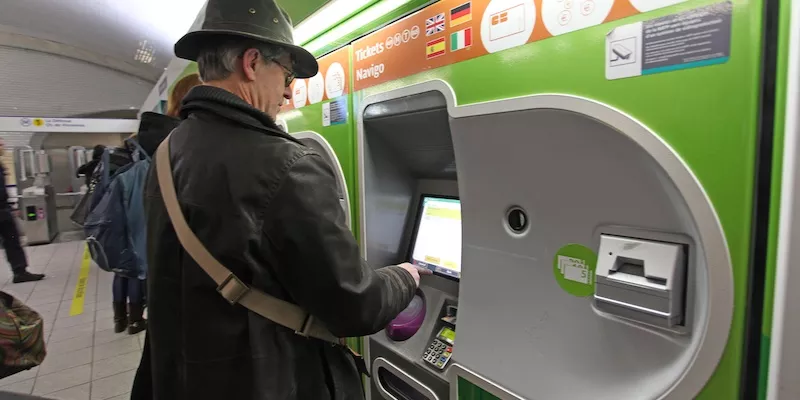
There's a new, modern way riding the Paris Metro. The traditional rectangular cardboard Metro tickets have been replaced with a rechargeable plastic card called Navigo Easy — aimed specifically at visitors and occasional users. There is a one-time cost (about €2) to purchase a permanent card that can be loaded with Metro "tickets" at machines or ticket counters at every station across the Paris region. You can also reload the card from your phone using the Bonjour RATP app .
Recharge your Navigo Easy with either individual tickets or carnets (a pack of ten tickets, which costs less per ticket). A carnet is around 15€, versus around 2€ for a single ticket. The traditional paper tickets have been completely phased out.
Each ticket is good for one ride on the Metro, no matter how many changes you have to make. So, you can get from Parc de la Villette (in the far northeast of central Paris) to the sports complex at Porte de St Cloud (in the far southwest) on one ticket! (That entire journey, by the way, takes 45 minutes and only involves one Metro change.)
Discover What's On When You're Here...
Discover what's on when you're here, then & now – paris metro tickets vs navigo.
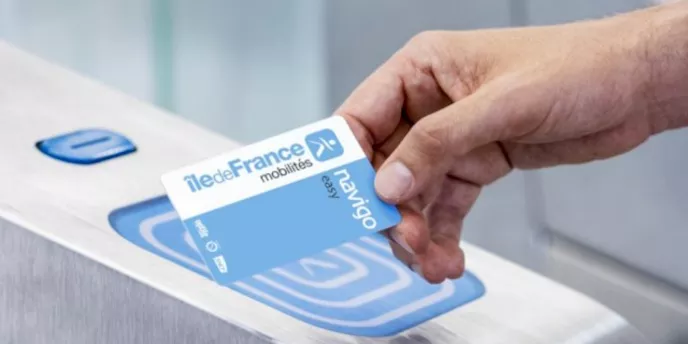
How it Used To Be – Using Paper Tickets
As you entered the Metro station, you would dig around in your pocket or bag to find a valid Paris Metro ticket. Then, you'd put the ticket into the slot on the front of the turnstile machine and push through. But, you also had to make sure to grab your ticket out of the machine as you left because you may have needed to show it to Metro security to prove you paid.
That Was Then, This is Navigo Easy
Take your card out of your pocket. Walk up to an entry gate. Tap your card on the sensor (like above). Walk through. That's it… you're in! You can lend card to someone else if you like, no ID is required.
Romantic Dinner Cruises In Paris
Paris metro etiquette & safety.
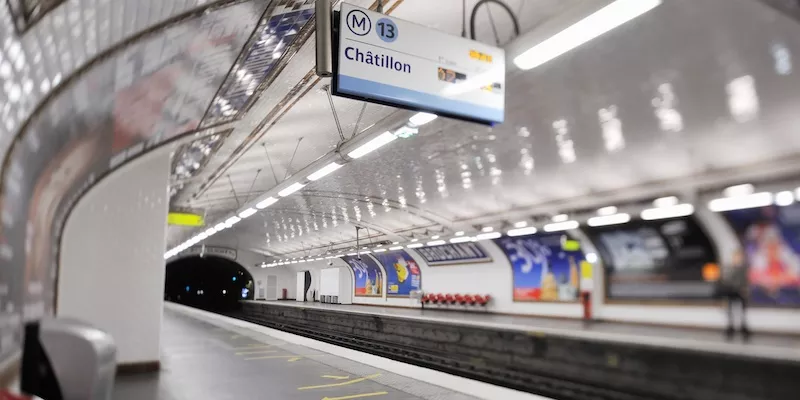
Just as in Paris restaurants , there is a certain etiquette observed on the Paris Metro.
- Speak softly.
- Don't eat or drink on the Metro.
- Keep your personal belongings on your body.
- Move aside for people who are leaving the train.
- When on the platform waiting for a train, leave some space around the doors for departing passengers.
- As a car fills up, move back to provide space for new passengers.
- When you have to get around other passengers to leave the train, simply say " pardon " (PAHR-doh) and they will let you by.
Find Hotel Deals for Your Dates in Paris
Useful underground information.
You can find additional helpful information about the Paris Metro in some of our other guides —
- Reviews of Metro Maps …
- Guide to the RER Rail System …
Paris Planning Guides
Copyright © 2010-2024 Voconces Culinary Ltd, all rights reserved. Original photos © Mark Craft, all rights reserved.
- • August 2024 in Paris…
- • September 2024 in Paris…
- • October 2024 in Paris…
- • November 2024 in Paris…
- • December 2024 in Paris…
- Paris Activities Month by Month
- Paris Olympics 2024
- Paris Events Calendar
- Museum Exhibitions Calendar
- Paris Ballet Calendar
- Paris Opera Calendar
- Christmas Day in Paris
- New Years Eve
- New Years Day in Paris
- Easter in Paris
- Valentines Day in Paris
- Bastille Day Celebrations
- Skip-the-Lines at the Eiffel Tower
- Visiting The Eiffel Tower
- Eiffel Tower Information
- See all…
- The Arc de Triomphe
- The Panthéon
- The Bastille
- Notre Dame Cathedral
- La Sainte Chapelle
- Sacre-Coeur Paris
- Chateau de Versailles
- Palais Garnier Opera House
- Hotel de Ville – The City Hall
- Get the Most from Your Visit
- Masterpieces of the Louvre
- Paintings of the Louvre
- Top 10 Van Goghs at d'Orsay
- Musée de l'Orangerie
- Centre Pompidou
- Musée Picasso
- Rodin Museum Paris
- Cluny Museum Paris
- Arts et Metiers
- Guimet Asian Arts Museum
- Galliera Fashion Museum
- Versailles the VIP Way
- Versailles History & Highlights
- D-Day Landing Beaches
- Monet's Gardens at Giverny
- Mont Saint-Michel
- Monet + Van Gogh
- VIP Private Day Trips
- 10 Ways to Skip the Lines
- 9 Most Romantic Things to Do
- 5 Top Activities In The Marais
- Lunch & Brunch Cruises
- Cruises with Extras!
- The 6 Best Evenings In Paris
- Moulin Rouge
- Paris at Night
- Hop-on, Open-Top Buses
- The 6 Best City Tours
- Private Tours of Paris
- Champagne & Shows
- Top 10 Walking Tours
- Mysterious Walking Tours
- Top-Rated Hotels in the Marais
- The Best Left Bank Hotels
- 10 Affordable 4-Star Hotels
- See all …
- Latin Quarter Hotels
- Left Bank Hotels
- Top-Rated Montmartre Hotels
- Favorite Designer Hotels
- Shangri-La Paris
- Hotel George V Paris
- The Royal Monceau
- Le Cinq Codet
- Peninsula Hotel Paris
- Hotel Le Burgundy
- Ibis Hotels
- Les Hotels de Paris
- Best Western Hotels
- Saint-Germain-des-Prés
- Top 10 Food Experiences
- Paris Wine Tastings
- Chocolate Tours
- 10 Best Cheese Shops
- The Best Baguette in Paris
- Food Markets of Paris
- Le Jules Verne
- Astrance Paris
- Il Carpaccio
- How to Choose a Restaurant
- The Best Paris Bars
- In the Marais
- On the Left Bank
- Historic Brasseries of Paris
- Michelin 3-Star Restaurants
- 6 Michelin-Star Restaurants
- See All…
- Best Paris Terraces
- Seine Dinner Cruise
- The Top 8 Tourist Attractions
- 5 Paris Itineraries
- Gardens & Parks
- Paris Hotels for Christmas?
- Best Restaurants in the 8th?
- Best Way To Visit Versailles?
- VIP Burgundy Wine Tour
- Burgundy Accommodations
- Napoleon's Paris
- Hemingway's Paris
- Medieval Paris
- 10 Tips For Visiting Paris
- 7 Vestiges of Roman Paris
- 13 Hidden Places In Paris
- Hidden Landmarks
- The Catacombs
- Pere Lachaise Cemetery
- Jardin des Tuileries
- Jardin des Plantes
- Palais Royal
- Rue des Barres in the Marais
- Waterfalls of Paris
- Arcades of Paris
- Airport Transfers
- Paris Airports
- Airport Taxis
- Train Travel From Paris
- Eurostar: London & Paris
- Paris Train Stations
- The Latin Quarter
- Saint-Germain-des-Pres
- Essential Facts for Visitors
- Taxes, Tipping & Etiquette
- What to Wear in Paris
- Maps of Paris
- The Paris Metro
- Paris Metro Tickets
- Paris Taxis
- Seine River Dinner Cruises
- Visiting Versailles
- Essential Day Trips
RELATED LINKS
On this page, paris public transport, tourist transport & passes, from paris to..., from europe to paris.

- WHERE TO STAY
- Charles de Gaulle Airport
- Orly Airport
- Beauvais Airport
- Paris public transport
- CDG Airport transfers
- Orly Airport transfers
- Hop on/off sightseeing buses
- Getting to Disneyland
- Getting to Versailles
- Louvre Museum
- Eiffel Tower
- Disneyland Paris
- Palace of Versailles
- Sightseeing passes
- Paris tours
- COVID-19 INFO
Paris Metro ticket prices, maps and passes
Tickets and travel passes in paris and in advance for visitors using metro.
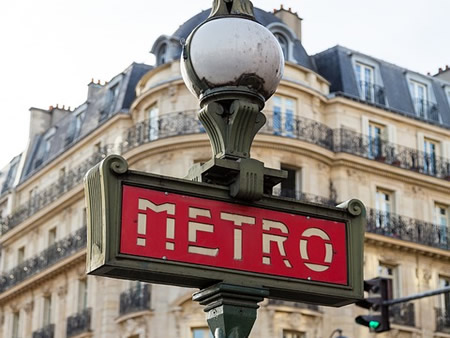
About Paris Metro
The Paris Metro service is for most visitors and locals the transport mode of choice when travelling within the centre of Paris.
There is a spider's web of lines, so in the centre of Paris you are always only a few minutes' walk from a Metro station.
The Paris Metro is run by RATP, (Regie Autonome des Transports Parisiens) who also run the Paris buses and RER suburban train system. As a result the transport network is highly integrated, tickets are interchangeable between buses, metro and trains.
The RER is a suburban rail system whose lines do not terminate in a central station in Paris but go right through to a destination on the other side of Paris.
In the centre of Paris the RER runs underground stopping only at major interchange stations. The RER can therefore be very useful for some cross-city routes and are certainly speedier as stations are much further apart than the Metro.
The bus network really only plays a supporting role to the Paris Metro in the centre of Paris. You will find yourself using the Metro for the majority of your journeys.
Using Paris Metro maps Paris travel zones Metro tickets and fares Buying your tickets Paris Visite card
Using Paris Metro maps and finding your way
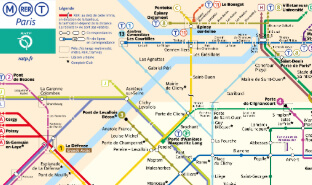
Paris Metro/bus maps are free and most reliably available at the tourist offices scattered around the city.
On one side is a very good, detailed map of Paris with the Metro and RER lines marked together with the numbers of the buses that interchange at Metro and RER stations.
On the other side is a detailed bus map.
Paris public transport is divided up into zones that radiate out from the centre. For perhaps the majority of visitors they will not go outside the central zone (zone 1).
Zone 1 is where nearly all hotels are and where all the city centre sights are located. The Paris Metro system is pretty much restricted to the inner 2 zones for which there is a flat fare structure.
If you interchange from the Metro to the RER, perhaps to Disneyland, Charles de Gaulle Airport (CDG) or Versailles the RER train may well go out to zones beyond that covered by a Metro ticket.
For most lines the first train is about 5.30am and the last well after midnight. Frequencies are very high, a few minutes between each train at most. There is a strict non-smoking policy.
Masks are currently mandatory on public transport for those aged 6 and above. They are also mandatory at other enclosed spaces. You do not need to wear a mask outside unless you are in an area with lots of people gathering, such as a bus stop, flea market, metro platform, stadiums, queues etc.
Top of the page
Paris travel zones.
The Paris public transport system is divided into circular zones that radiate out from the central zone, zone 1. For the Metro, only a few lines breach zone 1 at their extremities.
For this reason we do not go into zones here. If you use the RER to places like Disneyland, the airports or Versailles you will require tickets valid for these outer zones. Full details are at our Paris RER trains page.
Paris Metro tickets and fares
To access the Metro system you will need a ticket of one kind or another. Whatever ticket you have, (including travel passes ) you insert the ticket into an automatic barrier which after validating the ticket allows you through.
The first time, just position yourself behind a local and follow what they are doing - it really is simple and identical to many other systems like the London Underground.
In the Metro you can use 1 ticket and make any transfers between lines with only that 1 ticket so long as you're underground and in the Metro system itself. Keep it with you until you exit because some Metro or RER stations require it for you to leave.
So long as you stay underground a single Metro ticket also lets you use and transfer between the RER and Metro stations that are inside the 2 zones of Paris itself.
A single ticket is valid for one journey and can be used on the Metro, RER, Bus and Tram within Paris and its immediate suburbs.
Single tickets are sold either individually or in a pack of ten single tickets, called a 'carnet'. You can buy tickets at ticket offices or automatic ticket machines at Metro, bus, tramway and RER stations.
Save money, go contactless
The cardboard t+ ticket packs of 10 have now been entirely replaced. The reasoning is that these types of tickets often get lost, so not all the tickets are used as one is put away somewhere and lost. The cardboard magnetic strip gets easily demagnitised and can no longer work and there are better electronic solutions now available.
From 13 October 2022, cardboard t+ ticket packs were no longer sold from vending machines at 182 stations and bus stations.
As a visitor your alternative is Contactless t+ ticket packs of 10, these are actually €2 cheaper overall than the cardboard version. You can also get a Navigo Easy Pass for €2 which you can top-up at ticket machines and retailers or with your smartphone. Finally, you can still buy a single use ticket on board the bus for €2.10.
PARIS SINGLE TICKET FARES (T+ TICKETS) 2024
For use on one journey of the Paris Metro or Buses or on zone 1 RER trains in Paris.
Public transport passes
T+ tickets are a convenient option if you just need the odd journey around Paris over 1 or 2 days.
If you are using public transport more extensively for your visit to Paris there is a wide range of passes available. We have a dedicated page for these so you can identify the right public transport for your needs.
Paris public transport tickets and pass details
Buying your tickets
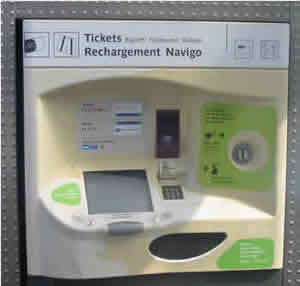
Once in Paris it is easy to buy tickets from manned ticket offices and automatic ticket machines. There are several variants of ticket machines, most have a choice of languages including English.
The ticket machines are reliable and sell a range of transport tickets, few people will be buying the single T+ tickets.
We would recommend you take a few minutes to read the other ticket types available as they well be more economical and convenient than single tickets.
Paris Visite card - transport pass for tourists
Using the Paris Visite travel card, you will be able to use all the public transport services in Paris. The metro pass consists of a simple ticket, no photo required.
It provides travel rides in Paris (with no limit) on the transport system including Metro, RER (regional express trains), bus, tramway, suburban Transilien SNCF trains, Montmartre funicular, Noctambus, Optile bus system and Montmartrobus.
As well as being a travel pass the ticket also provides discounts to tourist attractions though not the main head-liners like the Eiffel Tower and Louvre Museum. Typically a 20% discount on entrance to the Arc de Triomphe which may not be a high priority for you.
Visite card - more details
Public transport passes for locals available to visitors
The Paris Visite/Paris Metro Pass is heavily marketed at tourists by both Paris authorities and the tourist sector, many visitors are unaware that there are alternatives.
If you are using public transport a lot in Paris or are staying for more than the 2 or 3 days of the average visitor then these are worth evaluating.
Local Paris public transport pass - more details
Public transport + tourist attraction passes
There are quite a few options available combining public transport passes combined with tickets to some of the leading Paris attractions.
For the visitor only in Paris a day or two these can make a lot of sense, offering a one-stop solution to getting around Paris and visiting the main sights in one convenient package.
Paris public transport and visitor passes/bundles

This website uses cookies to improve your browsing experience and analyze the use of the website. Learn More

Which Paris Metro Pass to Buy

Sometimes when we're leading one of our free Paris walking tours, our guests will ask about how to get back to their hotel or find a popular attraction they want to visit.
That's one reason why we decided to write this article to provide information about buying transit passes in Paris, including details about ticket types and prices.
In addition to covering each type of ticket and pass, we will also include information about how to pay for the metro in this city.
- Ticket Types & Prices
- Metro Passes & Prices
- Travel Passes
- Tips From Locals and Travelers
With the sprawling transit network in and around Paris, there are many different types and prices of tickets.
RATP is the name of the agency that manages public transit in and around Paris, so you will get used to seeing its logo as you make your way around the city.
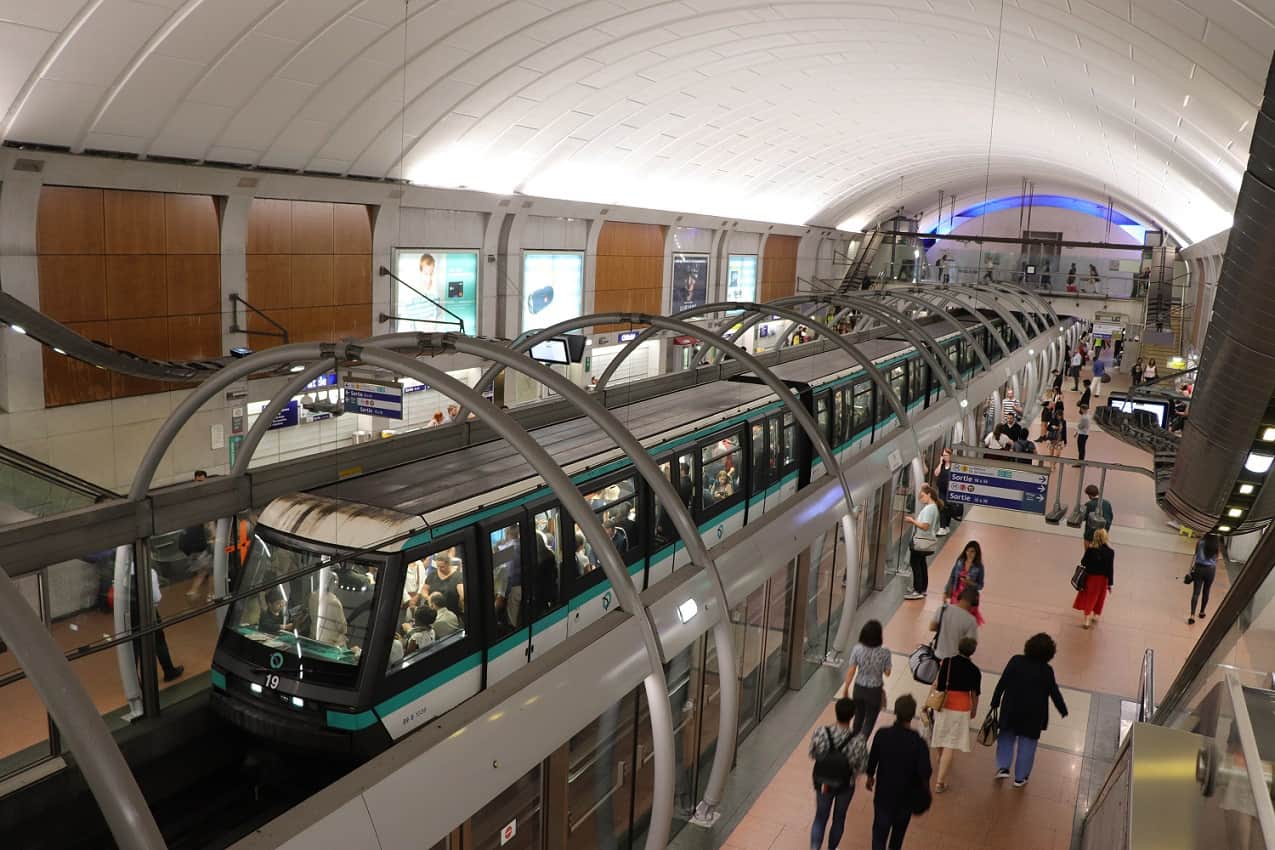
Before we get started, here’s the deal: Everyone aged 4 and older needs a valid ticket to use public transit in Paris.
Children ages 3 and younger ride for free although they can't take up a seat.
The RATP website has lots of helpful information in English, including a trip planner , a Paris metro map , and more.
In general, most visitors should be able to get to everything they want to see with individual t+ tickets purchased through various apps. We explain more about this below.
Note that there are also many different kinds of passes, some of which can save you some serious money and hassle.
For example, the Paris Visite pass comes in 1-day, 2-day, 3-day, and 5-day versions and can be ordered for either zones 1-3 (Paris proper) or zones 1-5 (which includes the airports, Disneyland Paris and Versailles).
Navigo offers weekly, monthly, and annual passes and a pass specifically for those 25 and younger .
Are you confused? Don’t worry - we’ll break down the different options so you can figure out what works best for you for getting around Paris.
View this post on Instagram A post shared by Roni Faida (@ronithetravelguru)
How do you pay for the Metro in Paris?
Contactless credit card usage.
While you can't simply use a contactless credit card to pay for entrance on the Paris Metro, you can use one to purchase a Navigo Easy Pass, which is itself a contactless form of payment.
Passes and Tickets
As we mentioned, you can buy a Navigo pass to pay for the Paris Metro. This is one of the easiest methods, but you can also buy paper tickets and use them to get around as well.
Tickets and passes can be purchased via the following methods:
- Ticket Machines
- Ticket Offices
- Metro Stations
- Retailers using the RATP sign
The Best Metro Ticket For Getting Around Paris
The best ticket for you depends on how long you're planning to stay.
If you're only going to be here for a few days, a carnet of tickets (a 10-pack of tickets) might work just fine.
However, if you're going to be in Paris for a week, you might want to get a day or weeklong pass to make things easier.

TICKET TYPES AND PRICES
There are a few different types of standard tickets available, so you’ll have to consider where you plan to go and how long you plan to spend there.
Single Tickets/t+
The simplest way to get around is to purchase a paperless/contactless ticket, however, you can also get paper tickets. Word is that these are expected to be phased out by the end of 2024.
Single one-way tickets , called t+, if paper, are still sold through machines in RER/train and Metro stations, but no longer at manned station counters.
To purchase a paperless/contactless t+ ticket instead, you first need to purchase a pass to upload it onto. See below under Metro Passes and Prices for information on the various passes you can choose from.

Once you have the pass, you can then load it/purchase tickets and ticket packs through the following apps: Bonjour RATP and Île-de-France Mobilités and any ticket counter or ticket machine.
- Single t+ tickets: €2.15
- Carnet/10-Pack t+ tickets: €17.35. This is only €1.74 per ticket, which is around a 19% off.
t+ tickets are valid on the metro as well as Zone 1 RER lines, some Île-de-France and tramway lines, and the Montmartre funicular.
You can transfer for up to 90 minutes between metros and RERs, and between buses and trams, on a single t+ ticket .
(Yes, there are also trams, but they only run in the suburbs, so most tourists never use them.)
Point-to-Point Tickets
While the t+ tickets will get you around Paris, if you have farther-flung destinations like Versailles, Disneyland Paris, or the Charles de Gaulle airport, you can purchase point-to-point tickets to get there and back.
This ticket type does not have set prices, and the cost depends upon where you’re going and how far it is between the stations you are traveling between.
Use the quick calculator on this page to see how much tickets cost between destinations.
METRO PASSES AND PRICES
Paris has refillable cards for its transit system, similar to London’s Oyster card or the SmarTrip card in Washington, DC.
These travel cards can be used for future trips to Paris and eliminate the need for paper tickets floating around your pockets (and possibly getting lost!).
View this post on Instagram A post shared by Paris France 🇫🇷 Travel | Hotels | Food | Tips (@paris.explore)
Navigo Passes
Here we cover several Navigo passes to suit your travel needs. All involve physical cards that can be used on the metro, but they also allow for phone swiping as well.
The Navigo Easy Pass is great for the short-term tourist. It lets you top up a few different types of tickets and is valid for 10 years. It's also not tied to your name so others can use it, although not during the same trip.
You can purchase a Navigo Easy Pass for €2.00 at any counter in any station and at RAPT-approved shops (such as Tabac and newspaper kiosks). Here's a full list of locations here , sorted by arrondissement.
Once you have the pass, you can then top it up with payment for the types of tickets you want.
You do this through the Bonjour RAPT app, the Île-de-France Mobilités app, at RAPT-approved shops, station ticket counters, or at station ticket machines.
For "occasional or regular passengers and tourists for short periods" you could also do the Navigo Decouverte Card.
The card is personalized with your picture on it so others cannot use it. The cost for the card is €5.00 and you would then, as the the Navigo Easy Pass, upload your chosen tickets onto it.
Fun fact: you will find photo booths all over Paris (ever seen the movie Amelie ?) if you don’t already carry around tiny pictures of your face.
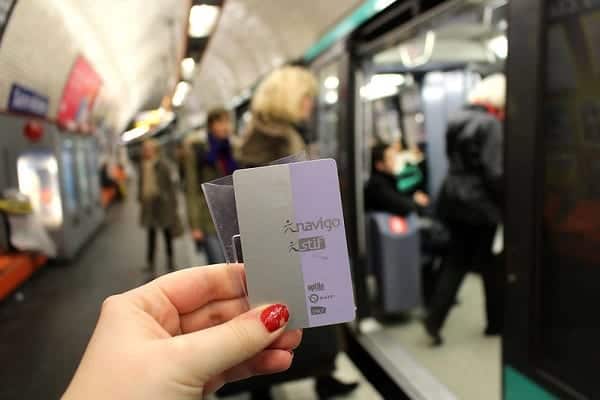
The Navigo Weekly Pass ( Navigo Semaine ) may be the best option for tourists visiting Paris, provided a few things:
- You are staying in Paris for three or more days.
- You are arriving in Paris before Thursday at midnight.
- You are planning to use public transit several times a day.
It costs €30.75 for seven days of transit across the entire Paris metro system, including Metro, RER, trams, buses, and even the Montmartre funicular.
The downside to Navigo weekly passes is that they are only valid Monday at 12:01 a.m. through Sunday at midnight, and can only be purchased for the current week until Thursday at midnight.
After that, if you buy a Navigo weekly pass, it will only be valid starting the following Monday
If you’re lucky enough to stay more than two weeks, consider the Navigo Monthly Pass ( Navigo Mois ) which is valid beginning the first of the month.
It gives you unlimited travel for a month and the cost depends on the zones you'll be traveling in.
Paris Visite Passes
The Paris Visite passes can be a good option for visitors.
They come in 1, 2, 3, and 5-day increments, and you can purchase them for either zones 1-3 (central Paris and close-in suburbs) or zones 1-5 (which includes airports, Versailles, Disneyland Paris, St. Denis, and more).
It works on every form of public transportation within those zones.
The passes also give users money off of several Paris attractions, and they can take some of the guesswork out of how many tickets to buy ahead of time.
Paris Visite can also be purchased as part of the Paris Passlib package , which includes the Paris Museum Pass, a boat ride, a bus tour, and more.

For a rough idea as to whether a Paris Visite pass is more economical than a single t+ ticket costing €2.10, here is how many times you would need to ride in a certain period for the cost-per-ride to be less.
- Equal to almost 7 t+ tickets
- Equal to almost 6 t+ tickets per day (12 total)
- Equal to almost 5 t+ tickets per day (15 total)
- Equal to 4 t+ tickets per day (20 total)
The math changes a bit for the Zone 1-5 Paris Visite passes, which can then cover your ride to the airport and anywhere else on the RER, such as Versailles.
- 1-Day Zone 1-5 Pass: €29.25
- 2-Day Zone 1-5 Pass: €44.45
- 3-Day Zone 1-5 Pass: €62.30
- 5-Day Zone 1-5 Pass: €76.25
Note that Paris Visite passes are half-price for children.
You can purchase Paris Visite passes at Charles de Gaulle or Orly airports, any Metro or RER station, visitor centers, or other authorized vendors.
It's valid from the first time you use it, and your first and last name must be written on it with the dates of validity.
Mobilis One-Day Pass
What if you’re only going to be in Paris one day? Quelle dommage! (Well, one day is better than no days, right?)
Or perhaps there’s only one day you know you’ll be using Paris public transit.
Whatever the case, you might want to consider the Mobilis One-Day pass . It’s available in the following options.
We’ll compare the price to standard tickets to give you an idea of how you might use them.
- Equal to 4 t+ tickets
- Equal to 5 t+ tickets
- Equal to 6 t+ tickets
- Equal to 9 t+ tickets OR
- 1 RER Airport transfer (€11.40) and 4 t+ tickets
If you plan to move around the city a lot in one day and you expect to use the Metro more than 6 times, this pass could save you a lot of money and it will save you some time.
Are you arriving in Paris by train? Buy a one-day Mobilis pass and ride four times to get your money’s worth. Mobilis passes are available at all RATP vendor points.
Note that the pass is only valid for one calendar day, i.e. from midnight to midnight.
View this post on Instagram A post shared by Shuba - Singer & Musician (@shubamusic)
Passes for Young People
While children 4-11 get special deals with all the other passes, those aged 25 and younger can take advantage of special transit passes for youth.
The Navigo Youth Weekend Pass is like the other passes - available from midnight to midnight - but they are only available on weekends and holidays. Passes are a great deal:
- Zones 1-3: €4.70
- Zones 1-5: €10.35
- Zones 3-5: €6.05
This pass is contactless and is one of the types of tickets you can upload to your Navigo Easy Pass.
If you buy a zone 1-5 ticket upon arrival at the airport, by the time you get into downtown Paris it will already have paid for itself, because the RER Airport Transfer is €11.40 on its own.
If you buy a zone 1-3 pass once you’re already in the city (such as arriving by train or bus), you only need to take three trips on public transportation to make it worth the cost.
For those under the age of 26 who are studying in Paris at a high school or university, the Imagine R Pass covers all zones for one whole year, for €375.00 -- which is just over €1 per day!
Ticket and Pass Savings
There are a few ways to save for visitors to Paris, though there are some exceptions.
- Children aged 4 to 10 , and groups of students traveling with chaperones (who must carry a Declaration of Honor ), are eligible for half-priced fares.
- Depending on how you use the Paris Metro Passes, you could also save a lot of money on tickets simply by using the card as many times as possible. Since each pass provides unlimited rides and they all have one flat price, the more you use them, the more money you’ll save.
TIPS FROM LOCALS AND TRAVELERS
While we do our best to provide all the information you'll need to ride the Paris Metro, sometimes you need answers to specific questions related to your personal experience.
Thankfully, our Paris Travel Tips group on Facebook is the perfect place to look for any answers you may need.
Here are a few examples of interesting and helpful tips and tricks provided by members of our group:
- Here is what a few folks have to say about what to see during a short time in Paris and about how best to get around.

2. To locate a metro station, look for lampposts or wrought-iron entryways that have METRO or METROPOLITAN written on them.
3. Ticket machines in the stations can be set to other languages, including English, and are easy to use. They accept both cash and chip-and-pin cards.
4. The direction of the train is indicated by the name of the last station on that line.
5. The doors to the train do not always open automatically. You need to push the open button or unlatch in the older trains.
6. You can (and many Parisians do) unlatch the doors to open them before the train comes to a complete stop.
7. If you need to change trains, look for stations denoted by a white circle, which will then have the different train lines that stop there underneath.
8. Paris Metro Lines are numbered and color-coded.
9. You'll need to know the last station to know what direction you're heading. There will be a list of stops on each platform, so it's not hard to follow.
10. Stations where you cannot transfer have solid circles.
11. The Paris Metro is open from 5:30 am - around 1:15 am (2:15 am on weekends/holidays).
12. Keep moving. When you board a train, move to the center. When you get off a train, move away from the doors if you need to figure out which way to go. There is almost always someone behind you trying to get off of the train.
Related Posts
- Tips from Using the Metro
- Hop-On-Hop-Off Bus Tours
- Eiffel Tower Tickets
Choose a Destination... I want them all PLUS general travel tips. Amsterdam Berlin Boston Charleston Chicago Dubai Lisbon London Los Angeles Miami Nashville New York City New Orleans Paris Philadelphia Prague Rome San Francisco Washington DC
About The Author

North America
United kingdom & ireland, middle east & india, asia & oceania.
- Weather & Climate
- The Airports of Paris
- Neighborhoods to Know
- Driving in Paris
- Paris Public Transportation
- Tipping in Paris
- Top Things to Do
- Free Things to Do
- Things to Do With Kids
- Best Paris Parks & Gardens
- Best Museums in Paris
- Cabaret in Paris
- Live Music in Paris
- Shopping in Paris
- Bastille Day in Paris
- French Dishes to Try in Paris
- The Best Restaurants in Paris
- Where to Eat With Kids
- Nightlife in Paris
- Craft Beer Bars in Paris
- Search Please fill out this field.
- Newsletters
- Destinations
Getting Around Paris: Guide to Public Transportation
Learn to Use the Paris Metro, Bus, RER & Tramway System With Zero Stress
:max_bytes(150000):strip_icc():format(webp)/profilepic-CTraub-5b6ff65d46e0fb00505577c1.jpg)
TripSavvy / Taylor McIntyre
Paris boasts one of the world's safest and most efficient public transportation systems. While the metro subway system is extensive, it's generally safe and easy to use once you familiarize yourself with it a bit. Trains usually arrive on time; buses are well-appointed and spacious, and commuter express (RER) trains service the city's most important stops in record time. What's not to love?
There are admittedly a few things that travelers can find confusing or downright unnerving about the French capital's transportation system. For one thing, trains and buses are more often than not overcrowded — and Paris' status as one of the world's most-visited cities doesn't help matters. For another, many metro lines lack air-conditioning — positive from an ecological standpoint, but watch out for those summer steambaths (and grouchy travelers). Public transportation here is also notoriously lacking with accessibility to disabled visitors. Gym rats may rejoice at the endless tunnels and stairs that snake through the Paris underground, but after a day visiting the city, the lack of elevators or escalators in some stations can be a real headache. Parents with young children or strollers may find this point particularly frustrating.
The good news? The Paris city government takes public transport very seriously, and every year a big chunk of the budget is reserved for improving traffic and passenger conditions in Paris trains, buses, and tramways. In the coming years, you can expect Paris public transportation to become more efficient, accessible and comfortable. Lots of new stations are also being added, making it easier than ever to get around.
Keep reading to learn how to navigate Paris public transport like a pro, including advice on the best tickets and passes, plotting your trip, safety and more.
How to Ride the Paris Metro: Tips & Tricks
- The Paris metro system has a total of 16 lines identifiable by number, color, and end-of-line names. These will help you figure out whether you're heading in the right direction and assist in planning line transfers.
- For example, line four is magenta, currently has 27 stations, and is called "Porte de Clignancourt/Mairie de Montrouge" because it runs from the Mairie de Montrouge station south of the city to Porte de Clignancourt in the north.
- Accordingly, you should always first figure out which direction you need to go relative to the line's endpoints. If you are at Chatelet and need to get to Odeon, you'd look at the map and see that Odeon is located south of Chatelet, toward Porte d'Orléans.
- This is important because once you take the metro in one direction, it's impossible to change directions without exiting the turnstile and going through again. This becomes a costly mistake if you have single tickets, rather than a weekly or monthly pass. In addition, certain lines (notably lines 7 and 13) fork in several different directions at key points, so make sure to check your destination carefully before getting on one of these trains, ensuring that the train you're boarding goes to your stop.
Hours of Operation
- During normal operating times, the metro runs Monday through Thursday and Sunday from 5:30 a.m. to 12:40 a.m., and Friday and Saturday from 5:30 a.m. to 1:40 a.m. The same late services also run the night before a public holiday.
- To ensure you catch the last train, you should generally aim to arrive at the station approximately 30 minutes before closing, as final trains depart at different times depending on the station.
- Certain metro lines open all night long for certain holidays and city events, including New Year's Eve and the October museum and exhibitions event known as Nuit Blanche (White Night). If participating in these events, check the official Paris public transportation authority website for more information .
Safety on Paris' Public Transportation
The metro and other public transport is generally safe, but pickpockets operate on many lines. Keep your wits about you and your valuables close to your person. See this page for more information on traveling safely , including advice on what to do in case of an incident or emergency.
Accessibility
- Only certain Paris metro lines are wheelchair accessible. If you have disabilities or limited mobility, check the box for accessible itineraries at this page .
- Onboard trains, passengers are obligated to give up their seats to travelers with disabilities, elderly passengers, pregnant women or passengers traveling with small children. Don't hesitate to ask for a seat if you need one, and remember to look out for any travelers who may have difficulty standing, and offer them your seat.
Where to Buy Paris Metro Tickets
You can buy tickets and passes for Parisian public transportation networks at any metro, RER or tramway station, and when boarding buses. They are also available at Paris Tourist information centers around the city, and can sometimes be found at newsstands or tabacs (tobacco vendors).
- When purchasing tickets from an automatic distributor in a Metro or RER station, only debit cards and coins are accepted in some stations. If you have only bills you may need to purchase tickets from a vendor at the "Vente" (Sales) desk.
- When boarding Paris buses, pay in exact change. Remember that your metro ticket usually does not allow for transfers to the bus; you'll need to pay for a transfer by asking the bus driver. Tell the driver your destination when you board so he or she can charge the correct fare. If you plan to use the bus frequently, buy a " carnet " (packet) in advance from a metro station.
- You can change the interface language of the self-service ticket machines to English. This should make it easier to find the tickets you need, despite the machines' reputation for being a little less than user-friendly.
Paris Metro Tickets and Passes: What Kind Should You Buy?
Depending on the length of your stay, how much you'll use public transport, and whether you plan on day trips to places like the Chateau de Versailles or Disneyland Paris , you'll need to choose between single metro tickets, packs of tickets (called "carnets"), or one of several useful transport passes. Below is a rundown of your options and some tips on how to choose the right one. Never purchase tickets from vendors on the street or vendors hovering around the entrance to stations; these tickets might be counterfeited and could cost you later in fines and extra time and money spent.
Standard "T+" Metro Tickets
- These tickets are good for one metro, RER, bus, or tramway ride within Paris (zone 1 only), including transfers. You may transfer from the Metro to the RER for two hours between the first validation, as well as buses or tramways up to 90 minutes from the first validation. Always keep your ticket in hand.
- Special tickets are required for buses and trains traveling to and from Paris airports. See our Paris airport ground transport guide for more details.
- Buy these if you're staying for a short time and will use public transport sparingly. You don't plan to take day trips.
- As of October 2020, a single ticket costs 1.90 euros, while a bus ticket purchased onboard is 2 euros. A package of 10 tickets (" un carnet ") may be purchased for 16.90 euros, or 8.45 euros for children under 10. Airport tickets range from 2 euros to 17 euros depending on the mode of transport chosen.
The Paris Visite Pass: For Unlimited Travel
- This pass is good for unlimited travel in Paris (Metro, RER, bus, tramway, and regional SNCF trains) and the greater Paris region, for up to five days. Also provides special offers at select museums, attractions, and restaurants. For a list of current fares and details on how to use the pass, see this page .
- Choose this pass if you're planning to travel extensively around the greater Paris region. Choose the zone 1-5 card to see Versailles or Disneyland Paris, and 1-8 for greater coverage. As we explain in our complete guide to the Visite pass , it may be worth your while to buy this special ticket that allows you to ride freely on metro, RER, and buses and also allows entry to many popular Paris attractions . If you're planning on hitting several major museums and monuments on your trip, it's worth considering.
For more information on using the Paris Metro system, see the local transport authority RATP's official website (in English). You can download free maps, search timetables and plan your itinerary, as well as find information on current rates, network issues and other information.
How to Ride the Paris RER (Commuter-Line) Train System
The RER, Paris' commuter train system, consists of five express trains that travel within Paris and the greater region (contrary to the metro, which stops just outside the city limits). The RER can get you to your destination much faster since it stops at far fewer stops than the Metro.
The primary hub for outgoing and incoming RER trains is the Châtelet-Les Halles station. Other major hubs include Gare du Nord, St. Michel/Notre Dame, and Gare de Lyon. The RER, which is run by a different (public) company than the Paris Metro, can be a bit complicated at first, but the time gained is generally worth it.
For example, it takes roughly 10 minutes to get from Denfert-Rochereau in South Paris to Gare du Nord in the North on RER. The same route by metro adds at least ten minutes to your journey.
RER Lines, Routes, and Hours
Like the metro, RER lines are identifiable by letters (A through E) and end-of-line names. However, the RER is more complicated than the metro because each line breaks into different directions at a certain point, making it easy to get lost (and waste funds and time) if you hop on the wrong train. Follow these tips to make your journey go more smoothly:
- To avoid surprises, check your direction carefully before boarding, and use the train itineraries located in RER stations to help you get oriented. If in doubt, ask for help. If you have a smartphone or tablet, consider installing a Paris Metro/RER app. Many are free, and are very handy to have so you can navigate what even locals often consider to be a confusing system .
- Another tricky point in riding the RER is getting the fares straight. The RER covers five zones within the Paris region, and if you travel further than your ticket or pass allows for, you can be fined. Make sure your metro ticket or pass covers the zones you need for the destination, and if in any doubt, double-check your destination's zone and required fare with a ticket agent before boarding.
- Remember that you'll need to save your ticket in order to exit most RER stations.
Operating hours for RER lines vary, but on average the commuter trains run from 4:50 a.m. to midnight or 12:30 a.m. For itineraries and hours, consult the RATP itinerary-finder page.
How to Ride the Bus in Paris
When visiting Paris, trying to figure out how to use buses to get around the city can seem like a challenge. Yet the bus can be both more scenic and less claustrophobic than the metro or RER. Taking time to get familiar with the city's clean and pleasant buses can pay off. With a total of 64 lines operating within the Parisian city limits, you can get just about anywhere the metro will take you — and often to a wider variety of destinations.
If you're a disabled or elderly traveler, you may find taking the bus much easier: most are now equipped with ramps, unlike the metro which is still woefully inadequate where accessibility is concerned.
Lines and Stops
Bus stops are found all around the city and more often than not are hubs for several different lines. Recently, a majority of bus stops were equipped with electronic information systems that tell you when to expect the next bus. Neighborhood maps and bus routes are also displayed at most stations, as well as at Paris tourist information offices.
Paris buses are marked by double numbers and the name of the end of the line marked on the front. You can use T+ metro tickets or weekly and monthly passes to ride the bus, but if you've already used a single ticket in the metro, you can't transfer to the bus. You can, however, transfer between two buses without extra cost providing you do so within 90 minutes of boarding the first bus. Ask the driver to stamp ("valider") your ticket when you board the first bus.
Using Buses to Tour the City: An Inexpensive Alternative
Certain bus routes are particularly scenic and can be a cheap alternative to Paris bus tours. You can view a map of bus lines in Paris here .
- Line 38 runs north to south through the city center and provides memorable views of the Latin Quarter , the Seine river, or Notre Dame Cathedral .
- Line 68 offers a vantage of the Musee d'Orsay , Saint-Germain des Pres , the Seine, The Louvre , and the Opéra Garnier .
- Line 28 offers lovely views of the École Militaire, the Assemblée Nationale, the Seine River, the Grand Palais , and the Champs-Elysées .
- Line 96 winds through beautiful spots on the right bank, including Hotel de Ville, the medieval Marais neighborhood , and trendy Bastille.
Hours vary considerably, but major lines run from approximately 6:00 a.m. to 12:45 a.m. On Friday and Saturday, buses run up until 1:45 a.m. Buses leave from most spots around the city at intervals of 15 to 30 minutes.
How to Ride the Tramway in Paris
Paris had a tramway in the 19th century, which was subsequently dismantled and replaced with the metro. But a swelling city population and a need to connect Paris with its suburbs has led to the revival of the tramway in the city of light.
The city now has a total of 10 tramway lines running within Paris' city limits , mostly around the outer bounds and numbered T1 through T11.
- You can ride the tramway using regular metro tickets and passes, and it can be a nice way to see the city from above-ground and experience some of the capital's lesser-known areas.
- On the downside, trams almost never serve the city's big-ticket tourist attractions. This isn't the mode of transport most visitors will end up privileging, unless you choose to stay near the outer limits of the city.
- For itineraries on the Paris tramway, consult the RATP itinerary-finder page. Please note that you cannot purchase tram tickets on board, but tram stations are equipped with ticket vending machines.
Taking a Taxi in Paris
Many tourists wonder when or whether to take a taxi in Paris. The short answer is that you won't usually need to, unless you have special needs owing to a disability or limited mobility, or you don't like walking or taking public transportation.
If you do choose to take a taxi, make sure to keep these tips in mind:
- Never get in a taxi or agree to a ride unless it is equipped with a red and white "Taxi Parisien" sign on its rooftop and has a visible meter inside. Scams are common, and it can also be unsafe — especially for women traveling alone — to accept a ride without verifying the status of the driver.
- For short fares, drivers often prefer cash. For longer rides (e.g., across town or to the airport, Visa and MasterCard are generally accepted. It is unusual for cabs to accept American Express and traveler's checks are not generally accepted. Ask the driver before agreeing to a ride what forms of payment are allowed.
- Don't hesitate to give your driver a desired route. Be aware, however, that it is not unusual for drivers to have minimal English. Loading a map on a digital device and showing them your preferred route or destination can be helpful.
- At rush hour and during peak tourist months, traffic can be quite heavy. It may end up taking quite a bit longer to travel by taxi — which is why many tourists opt against it.
Getting Around by Bike in Paris
If you enjoy getting around by bike, you may wonder whether it's a good idea to attempt to do so during your stay in the French capital. While Paris does have a bike rental scheme called Velib', it has numerous downsides:
- Helmets, which are highly recommended, are not provided, so you'll have to bring or buy one yourself.
- Cycling lanes do exist in the city, but are inconsistent and safety conditions are often less than optimal for bikers, even experienced urban cyclists.
- The payment scheme for Velib' isn't especially well adapted to travelers, especially for short visits.
For all these reasons, we don't generally recommend Velib' to tourists. However, many tour companies offer guided bike and Segway tours around the city, including fun night tours. They generally provide helmets, know the best and safest routes to take, and watch out for visitors' general safety and well-being.
More Tips for Getting Around Paris
Paris is a relatively easy city to get around if you arrive armed with the right information. Here are some tips to help you navigate public transport like a local — and avoid unnecessary frustration and claustrophobia en route.
- Get a decent metro map. These are available free of charge from any metro information booth, and can also be downloaded online . There's no use scurrying around through the underground tunnels struggling to find your way. A map will do the trick.
- Some great free apps are now available for your smartphone, iPhone or tablet. The RATP transport company's own app, downloadable here, works well.
- Avoid riding the metro or RER (express trains) at rush hour, if you can. During these times, opt to walk or take the bus. One word of warning, though: some bus lines are also swamped at these hours.
- Metro lines 1, 2, 4, 11, 12, and 13 are generally the most overcrowded lines, especially at rush hour. Bus lines 38, 28, 68 and 62 are among the most cramped — but they also service many of the city's most central areas.
- Metro lines 6 and 2 run above-ground much of the way, sometimes offering impressive views of the city. Line 6 offers spectacular views of the Eiffel Tower near the Bir-Hakeim station. From line 2, a less striking view of the Sacré-Cœur can be seen.
- Learn to ride the RER when it makes sense to. Many visitors to Paris never set foot on board Paris' five higher-speed commuter trains, but they can be a boon if you need to traverse the city quickly from one point to the next. The RER is also quite useful if you're planning on taking a day trip to destinations including Disneyland Paris, Versailles, or the large park and "wood" known as the Bois de Vincennes.
- Take advantage of extended Metro hours on weekend nights; the last trains arrive at their final stop by 1:40 am between Sunday to Thursday. On Friday, Saturday and the evening before public holidays many lines run until 2:15 am. See the RATP timetables for full hours and schedules .
- Taxis can be a more time-consuming — and far more costly — way to get around. Especially in the city center and during rush hours, you can expect taxi trips to take quite a bit longer than the metro and even bus journeys. Buses often have dedicated lanes, while metro, RER and tramway lines avoid surface traffic altogether.
- In some cases, walking may be your best bet for a quick and more stimulating journey from one point to the next. Don't automatically hop on the metro or bus to your next destination. Instead, use Google Maps, a street map or the RATP Itinerary planner to check whether walking would actually be speedier. It's almost guaranteed to be more interesting — and you'll get some fresh air, too.
Related Articles
More related articles.
Ministère chargé des transports

Anticipate the Games
- Subscription to news alerts
Display settings
Forecasts about your trips.
Find details of the impacts on roads and public transport to plan your trips on Saturday August 31 in Île-de-France.
Find the details of the impacts on the roads and in public transport to anticipate your trips on Saturday August 31 in Île-de-France .

Opening ceremony of the Paralympic Games (August 28): what impact will it have on your travel in Paris?
Published on 26 August 2024
Security perimeters and Games Pass
From 20 p.m., the opening ceremony of the Paralympic Games will begin on Place de la Concorde and Avenue des Champs-Élysées, ending around 23 p.m. Many spectators and foreign delegations will use public transport and roads to get there, and security perimeters will be activated. So how can you anticipate your journey if you travel to Paris on the big day?
In this section:
Security perimeters, impacts on the road, impacts on public transport, spectator access, when and where does the opening ceremony of the paralympic games take place.
The opening ceremony of the Paralympic Games is scheduled for August 28 from 20h to 23h.
For this ceremony, the avenue des Champs-Elysées will be accessible for the popular parade (free access up to 15 places available) as well as Place de la Concorde for ticketed spectators.
The public reception takes place from 17pm with inspection by law enforcement.
Everything you need to know about the security perimeters of the ceremony
When are security perimeters activated.
The security perimeters of the ceremony will be activated gradually on Wednesday August 28, all along the route of artists and athletes.
Pedestrians and cyclists can move freely without proof within the red perimeter.
- Perimeter activation at 7 a.m.
- Perimeter activation at 14 a.m.

at 7h : red perimeter (visible in purple on the map) restricted activated and prohibited to motorized traffic (except on presentation of proof and after control by the police)

- red perimeter (visible in purple on the map) widened activated and prohibited to motorized traffic (except on presentation of proof and after control by the police)
- ban on access to the SILT perimeter between avenues de Marigny and Winston Churchill (to the west) and place de la Concorde (to the east) linked to its activation at 15 p.m.
- at 15h : activation of the SILT perimeter, accessible via filtering points, following inspection by law enforcement
When are security perimeters deactivated?
- 3h (August 29): deactivation of the SILT perimeter (excluding Concorde stadium)
- 7h (August 29): deactivation of the SILT perimeter (de la Concorde stadium)
- until August 31 : expected impact linked to dismantling
What are the terms of access to the perimeters?
Depending on the type of security perimeter, access methods differ:
View the activation of security perimeters
Consult the interactive map as of August 28 to view the exact location of the security perimeter and the Olympic routes. Scroll through the times to see how they change.

Roads: the impacts of the Concorde – Champs-Élysées sector
What are the impacts during the assembly and dismantling of the ceremony.
Before and after the event, certain roads are impacted by the preparation and dismantling of the event.
- Total closure of areas to the public.
- Total closure of the Champs-Elysées roundabout (north and south)
- From Thursday 29 at August 31 : impacts to be expected for dismantling in the 3 areas of the ceremony.
Olympic routes: which sections of road are impacted?
Avenue Charles de Gaulle, Avenue de la Grande Armée, Avenue Marceau and Cours Albert 1ᵉʳ are notably impacted by:
- an Olympic way , that is to say a lane reserved for accredited vehicles, which you must avoid by staying on the other lanes alongside;
- an Olympic route , i.e. a recommended route for official Games shuttles, which may cause delays.
Consult the interactive map on the date of August 28 to visualize the exact location of the Olympic routes (purple) and the Olympic routes (pink).
Learn more about Olympic and Paralympic lanes
185 km of lanes on the main roads around Paris will be reserved for the circulation of accredited vehicles. Discover the details of the impacts linked to their activation.

Public transport: the impacts to be expected in Île-de-France
Several lines will be particularly impacted on Wednesday August 28 between 18 p.m. and 23 p.m.
- Stations closed
Reminder of stations closed during the Games period:
Exceptional closures for the ceremony:
If you have to pass through these stations, we advise you to take transport before 18 p.m. After 18 p.m., the waiting time to access the platform may be longer due to crowds.
This also concerns all buses whose stops are in the area. The following lines may be diverted and certain stops not served:
Find out more about your bus line
To find out the real-time impact of the ceremony on public transport, go to the usual applications such as Hello RATP ou Île-de-France Mobilités.
Are you a spectator and wondering how to access the ceremony?
See you at Paris 2024 to find out all the practical information and the Paris 2024 Public Transport application to prepare your itinerary.
Access points to attend the ceremony
Several access points have been set up in the Champs-Elysées - Concorde sector for people attending the opening ceremony of the Paralympic Games. These concern access to places available with free access and people with a spectator ticket.

Frequently Asked Questions
Find all the answers to your questions regarding your travel during the Games.
Discover the news
Delivery professionals: what are the traffic rules during the paralympic games.
Advice for professionals
Published on 28 August 2024

Taking the metro during the Paralympic Games: the practical guide to getting around efficiently
Public transport
Published on 20 August 2024

Accessibility, disability and reduced mobility: how to get around Île-de-France during the JOP?
Published on 30 April 2024

Map of impacts on your travels
View public transport forecasts and traffic restrictions on the roads in Paris and Ile-de-France
Subscribe to information alerts
By entering your email address, you agree to receive our news by email. You can unsubscribe at any time using the unsubscribe links or by contacting us.
Follow us on social media

IMAGES
VIDEO
COMMENTS
Read reviews and view photos. Book a Paris Metro tour! Paris
Transport tickets and travel cards for the Paris 2024 Olympic and Paralympic Games. From 20 July to 8 September 2024, Île-de-France Mobilités will implement changes to transport tickets and travel cards. Disco... Visiting Paris. All transport passes and fares for the metro, RER, and bus - RATP.
The Paris Visite Travel Pass is a pass that gives you unlimited access to all forms of transportation be it the metro, bus, tram, RER, and SNCF trains in the Île-de-France region for either 1, 2, 3, or 5 consecutive days.. The daily price depends on the zones you select, starting at €13.95 for zones 1 to 3 and going up to €29.25 for zones 1 to 5.
Paris Metro Prices 2024. The Paris Metro ticket price is 2,15 €. The T+ ticket comes with a few discounts, which are the following: > A pack of 10 T+ tickets (called Carnet de Dix in French) costs 17,35 €, which means 1.73 € /ticket. > A pack of 10 T+ tickets at a reduced price (called Carnet de Dix Tarif Réduit in French) is available for kids from 4 to 9 years old and costs 8,65 €.
The Paris Visite package allows access to all transport networks: metro, tram, bus, RER and train (SNCF Transilien). This package, valid for 1, 2, 3 or 5 consecutive days, allows unlimited travel in Paris (zones 1 to 3) or Paris and the Île-de-France region (all zones, with access to airports including Orlyval, Disneyland Paris and Château de ...
The basic fare for a single journey on Paris Metro trains, buses, RER trains, trams, and funiculars is €1,90, but you can save money with stored-value cards and passes such as the Navigo Easy or Paris Visite. Please note that fares have nearly doubled during and immediately after the Paris Olympics from July 20 to September 8, 2024.
Paris 2024 travel card; t+ tickets; Origine-Destination single-trip tickets; ... Origine-Destination single-trip tickets (also known as Île-de-France tickets) are what you need! With them, you can travel on RER, metro, and SNCF networks for occasional journeys outside Paris, or travel between stations in the ÎIe-de-France region (suburb ...
The Navigo Day Ticket gives you unlimited travel for a whole day on all modes of transport* and in the zones you choose (from 1 to 5, from central Paris to the entire Île-de-France region). From €8.45 per day and depending on where you travel, choose the Navigo Day Tciket that best suits you. *except Orlyval and tourist buses.
Paris Metro prices as of Jan. 4, 2024 is 2.15€ for a one-way ride lasting up to 2 hours. (Note: your last transfer must be made within 1 hour 30 minutes. No further transfers are allowed after this time and you must complete your travel by the 2 hour mark.)
Depending on the zones you choose, the Paris Visite Pass gives you unlimited travel on: metro lines, RER lines, Île-de-France bus lines (except on Fileo, tourist circuits and Air France shuttles), ... Easy pickup at Spot24 and the ticket made the travel around Paris so easy and comfy!!! Thank you and see you next time. April S. 5 /5.
Valid from midnight on the first day to 23.59 on the last day, the Paris Visite Ticket gives you unlimited travel within the selected zones, on all modes, except Filéo. It is available for two different groups of zone: Zones 1-3 and Zones 1-5. To get to Orly airport (including OrlyVal) or Roissy-Charles de Gaulle airport, as well as certain ...
1 Ticket for Metro, Bus or RER within Paris: €2.10 Contactless t+ 10 tickets (as above) for adult (4-10 years) ... As well as being a travel pass the ticket also provides discounts to tourist attractions though not the main headliners like the Eiffel Tower and Louvre Museum. Typically a 25% discount on entrance to the Arc de Triomphe and 25% ...
Unlike individual metro tickets, this pass gives you unlimited travel in Paris (Metro, RER, bus, tramway, and regional SNCF trains) and the greater Paris region for several days at a time. You can choose between passes that cover all your travel 1, 2, 3 or 5 days, and--an added boon that many visitors appreciate--Paris Visite also gets you ...
Ask the clerk to top it up with a bundle of 10 tickets for €17.30. Alternatively, use the vending machines. Recharge with another bundle, or single tickets, if needed. If you visit Disneyland, Versailles, etc., buy a destination ticket at the station for €3 to €5. Navigo Easy Card App on your phone.
Navigo Easy - The New Way to Buy Paris Metro Tickets There's a new, modern way riding the Paris Metro. The traditional rectangular cardboard Metro tickets have been replaced with a rechargeable plastic card called Navigo Easy — aimed specifically at visitors and occasional users. There is a one-time cost (about €2) to purchase a permanent card that can be loaded with Metro "tickets" at ...
Price. 1 Ticket for Metro, Bus or RER within Paris. €2.10. Contactless t+ 10 tickets (as above) for adult (4-10 years) €17.35. Contactless t+ 10 tickets (as above) for child (4-10 years) €8.65. For use on one journey of the Paris Metro or Buses or on zone 1 RER trains in Paris.
5-Day Zone 1-3 Pass: €44.45. Equal to 4 t+ tickets per day (20 total) The math changes a bit for the Zone 1-5 Paris Visite passes, which can then cover your ride to the airport and anywhere else on the RER, such as Versailles. 1-Day Zone 1-5 Pass: €29.25. 2-Day Zone 1-5 Pass: €44.45.
The one-day Navigo travel card is valid for one day, determined by the customer at the time of purchase. It allows travel in the selected zones from 12:00 a.m. to 11:59 p.m. (For Noctilien buses, the one-day Navigo travel card is valid until 5:59 a.m. the following day). Airport information. If the one-day Navigo travel card covers: Zone 4 or ...
Where to Buy Paris Metro Tickets . You can buy tickets and passes for Parisian public transportation networks at any metro, RER or tramway station, and when boarding buses. ... This pass is good for unlimited travel in Paris (Metro, RER, bus, tramway, and regional SNCF trains) and the greater Paris region, for up to five days. Also provides ...
Paris Passlib' - Official city pass. Discover and book the official Paris city pass. Put together your own programme of activities: museum visit cruise on the Seine, bike tour or on foot... And during the Olympic and Paralympic Games, opt for the Paris Passlib' Jeux and its 8 included activities! BOOK NOW.
Ticket t+ on a Navigo Easy pass or smartphone is the right fit if: Your journeys are mainly by metro or RER in central Paris.; You travel by bus and tram throughout the Ile-de-France region.; You mainly travel with t+ tickets and you want a more practical and ecological solution.; You don't make enough journeys to justify a monthly or weekly Navigo pass.
Station agents, technical staff, and drivers: altogether more than 63,000 people work on behalf of our passengers. Join us. Public transport in Paris and Île-de-France: itinerary planner; metro, RER and bus maps; information on: traffic, fares, hours, areas….
From 20 p.m., the opening ceremony of the Paralympic Games will begin on Place de la Concorde and Avenue des Champs-Élysées, ending around 23 p.m. Many spectators and foreign delegations will use public transport and roads to get there, and security perimeters will be activated. So how can you anticipate your journey if you travel to Paris on the big day?
Tickets on your phone. The RATP app enables you to purchase your t+ tickets and Navigo monthly and weekly travel passes from your phone whenever and wherever you want! Networks: Number of journeys : variable. Ideal for : All passangers. Published on 4 August 2023.
The Navigo Easy pass allows you to top up these tickets: t + (single trip, full price set of 10, or reduced-price set of 10) OrlyBus and RoissyBus. Navigo Day Package. Navigo Youth Weekend. Antipollution package (available during pollution peaks) Your Navigo Easy pass is valid for 10 years.